On the hunt for a great new Spanish destination offering loads of charm, a fascinating sense of history, varied sights and delicious food? Let me present Pamplona, a vibrant university town in the northeast corner of Spain – and part of the greater Basque cultural region.
Pamplona is best known for its week-long festival of San Fermín – aka “the Running of the Bulls” – which takes place each year from July 6-14th. That is, except for this year, when the COVID-19 pandemic forced its first cancellation since the Spanish civil war in the 1930s.
2024 UPDATE: The Running of the Bulls was cancelled in 2020 and 2021 due to the COVID-19 pandemic in Spain, but resumed again in 2022.
Ernest Hemingway’s beloved novel, The Sun Also Rises (published in 1926), made Pamplona’s bull runs & festival known around the world. The city, with a population of around 200,000, swells to over a million people during the festival in honor of the city’s patron saint San Fermín.
In addition, Pamplona has a close historical connection to the Camino de Santiago, the famed 1000-year-old pilgrimage route which ends at the Cathedral in Santiago de Compostela (in northwest Spain) where the remains of the Apostle St. James lie in a crypt. The most popular route – the Camino Francés (French Way) – passes through Pamplona so the town is filled with Camino walkers (also known as pilgrims).
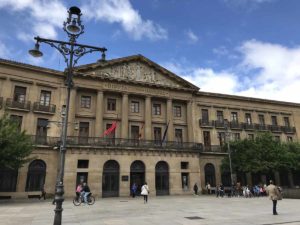
My Visit To Pamplona / Purpose Of Blog Post
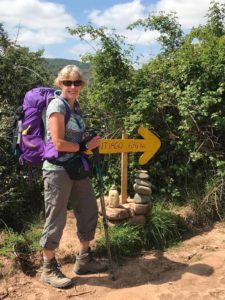
Regarding the Festival of San Fermín & the Running of the Bulls, I don’t necessarily recommend visiting Pamplona in July to experience the festival in person. The event is known for huge crowds, high prices, and some pretty crazy drunken revelry among some of the visitors and locals alike.
However, you can still vicariously experience some facets of the festival, like I did, by walking Pamplona’s streets where the bulls make their infamous runs. And you can visit the Plaza de Toros (bull ring) to learn more about this centuries-old tradition.
Whether you’re planning to visit Pamplona as part of “tourist” travels around Spain or as a Camino pilgrim, I want to share some recommended highlights for planning your visit.
Start With a Stroll Around the Plaza del Castillo
Pamplona’s beautiful main square is the Plaza del Castillo. It’s a huge open space surrounded by elegant buildings with covered arcades that shade the shops, bars and cafes within. The stone gazebo in the plaza’s center is a popular meeting place and a photographer favorite.
The Plaza is also a great place for an evening stroll, with its numerous cafes including Café Iruña (above left). Plus, there is the historic Gran Hotel La Perla, which has housed Ernest Hemingway, Orson Welles, and Charlie Chaplin. In fact, La Perla was Hemingway’s favorite place to stay. So, be sure to check it out.
Have a Drink at Café Iruna & Take Your Photo with Hemingway
Don’t miss the magnificent and sumptuous interior of Café Iruña, an art deco café founded in 1888. This historic café/restaurant is where famed writer Ernest Hemingway loved to hang out – and drink! – in the 1920s. Ernest developed a deep love affair with Pamplona. In fact, he came to the city a total of nine times for the festival of San Fermin and the bull runs.
Not surprisingly, Café Iruña’s bar & restaurant are featured heavily in Hemingway’s The Sun Also Rises, his first and most acclaimed novel. After you’ve popped into the cafe for a coffee, drink or a meal, make sure to pay homage to Mr. Hemingway by visiting his life-sized bronze statue in the bar adjoining the café. And, it’s mandatory to snap a photo with this literary legend!
Explore Pamplona’s Wonderful Old Town Streets
Pamplona’s delightful Old Town (Casco Viejo) is compact & easy to explore. Enjoy wandering the different main & side streets, checking out the many shops, cafes and restaurants. If you’re like me, you’ll be awed by the beautiful & eclectic architecture of the town’s buildings, not to mention many of them quite colorful.
One of Pamplona’s most beautiful buildings (above left) is the Casa Consistorial (town hall) with its splendid baroque façade overlooking a small square in front. The town hall was built in 1423. I love the ornate balconies, horn-blowing trumpet statues, and the colorful flags. Moreover, the festival of San Fermin begins and ends on a balcony of this building (with announcements from above).
Of course, what European city doesn’t have a beautiful cathedral, and that includes Pamplona. Its Catedral Santa Maria el Real is a 15th century Gothic structure with a neoclassical façade (below right). It has a 13th century cloister and the north bell tower houses one of the largest bells in Spain.
- Photo Credit: DepositPhotos / Cathedral (Town Hall to left)
Want to Know More About the Running of the Bulls?
Pamplona’s festival of San Fermín & the Running of the Bulls takes place each year from July 6-14th. There are 9 days of unbridled partying and lots of family-friendly activities within Pamplona’s Old Town. The Festival is split into two parts: opening day & the other 8 days which include morning bull runs, late afternoon/early evening bullfights, and nighttime parties.
Pamplona’s Running of the Bulls (El Encierro in Spanish) & the San Fermín festival didn’t really gain their current popularity until the early 1970s. However, they’ve both been a part of Spanish culture for centuries.
Each morning, at precisely 8:00am, six fighting bulls – bred for strength, size, and nobility – are released onto the street from the Calle Santo Domingo corral. They are accompanied by six highly trained steers (castrated male bovines) that help herd the bulls and keep them on course.
Human adrenaline-junkies line the bull run route, ready to sprint alongside and occasionally in front of these enormous bulls weighing upwards of 1,300 pounds. The total distance from the corral to the bullfighting stadium is around 900 meters – about half a mile. The bull run usually takes less than 4 minutes. Blink and it’s over!
After two rockets are fired, several hundred runners (called “mozos”) take off through the narrow Pamplona streets with the bulls charging right on their heels. Large crowds watch from street corners and balconies (for the best views!) – and millions more on television.
Later that afternoon (sometime between 5-7pm), tourists and locals fill up the Plaza de Toros bullfighting stadium to witness professional matadors fight the six bulls that were run earlier that day. Since 1910, 16 people have died while participating in the bull runs, the majority from being gored.
Here’s an excerpt from an interesting July 2019 Time magazine article about the history & future of the bull runs.
“The festival has been condemned, by Spaniards and foreigners alike, for its cruelty to animals, its atmosphere of toxic masculinity, and seemingly pointless risk to the participants. … But supporters say the running of the bulls is a centuries-old tradition and vital to regional culture.”
(This is me talking now) I’ll leave it up to each individual reader to judge! In addition, if you’d like to know even more and see great visuals, check out this excellent 6-minute travel video by Rick Steves filmed during the Festival of San Fermín & the Running of the Bulls.
Take a Vicarious Walk Along the Bull Run Route
If the “Running of the Bulls” holds a fascination for you (like it did me!), you can retrace the steps (or is that hoofs?) of the raging bulls from start to finish. Follow the signs labeled “El Encierro,” marking the bull run route through the narrow streets of Old Town.
Begin at the Bull Corral down by the river, where the bulls are released during the festival. The rest of the year, it’s a car park. First, the bulls run up Cuesta de Santo Domingo, turn left onto Calle Mercaderes (in front of the town hall), then make a sharp right turn onto La Estafeta. On this narrow street, there is no extra room for barricades, thus offering the runners no escape from the bulls. The route ends at the Plaza de Toros bull ring.
While in the area, make a short jog (around a block) to a pedestrian zone just outside Old Town to visit the Running of the Bulls Monument (Monumento al Encierro). Take a photo with these life-sized statues (above left) showing the bull run in action – including 6 bulls, 2 steer and 10 runners. Don’t forget to shop for bull run memorabilia in the local shops.
Take A Guided Tour of the Bull Ring
At the end of the run, the bulls charge down the ramp of the Plaza de Toros and through the red door which leads out to the bull ring & the bull corral in the back. The bull fighting ring is used only during the San Fermín festival. The rest of the year, the complex is open for self-guided and fully guided tours.
La Estafeta street will lead you right to the bull ring. Pamplona’s Plaza de Toros was built in 1923 and expanded in the 1960s. It holds around twenty thousand spectators, making it the third largest bull ring in the world, after Madrid and Mexico City.
- Credit: Plaza de Toros / Bull Ring Tour website
I definitely recommend taking a self-guided tour, which I found very interesting. The cost (around 6 euros) includes a helpful audio guide which leads you through the various stations. Besides walking out into the large bull ring, there are exhibitions and video presentations which capture the pageantry of the festival’s morning bull runs and evening’s bull fights. Plus, you can visit the corrals and stables, and a small chapel. Here’s more Info on the Bull Ring Tours.
Enjoy A Taste of Pamplona With Its Famed Tapas Bars
When it comes to food in Pamplona, you’ll have no trouble finding a good meal. After all, you are in Spain! However, tapas & tapas bars are a real specialty of Pamplona. Since it’s in the Basque region, tapas here are known by their Basque name – pintxos – so don’t be confused. Here’s a tip: they’re pronounced “peen-chos”.
La Estafeta (the famed narrow bull run street) is home to the best tapas bars in town, per travel guru Rick Steves. In fact, I enjoyed one of his favorite picks – Bar Cerveceria La Estafeta – on my first night in town.
- Tapas Bar – La Mandarra de la Ramos
- Tapas Bar – Bar Cerveceria La Estafeta
Camino guru John Brierly (writer of the best Camino guidebooks) recommends Calle San Nicolas, as a place filled with inexpensive tapas bars & pensiones. On this street, I went to La Mandarra de la Ramos for delicious tapas with a pilgrim friend. It was recommended by my nearby pension.
Bottom line: there is no one best place for tapas. The fun of a tapas bar is to try lots of different foods in their typical small portions. You just go up to the bar and point at the tapas on the different plates that you want to try. Then sit back and enjoy some great people watching while you feast.
Visit the Old Ramparts of Baluarte de Redin
Pamplona was founded by the Roman general Pompey around 75 BC and was built over a previous Basque encampment. Pamplona was more fort than city, contained within the large defensive walls until the 20th century when building was finally allowed to take place outside the city walls.
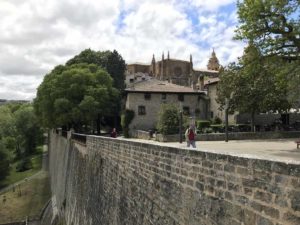
It’s a short walk up a street just inside the city walls to the top, where you will get some expansive views over the Rio Arga and the surrounding area.
In this peaceful park-like setting, you’ll find plaques detailing some town history. You can also enjoy a drink or meal at the nearby café Caballo Blanco, which was a former pilgrim hostel (above right). From here, take a small lane in the rear to walk back to the Cathedral and central part of old town.
Get A Taste of the Camino Pilgrim Experience
The Camino Francés pilgrimage route passes right through the heart of Pamplona’s old city. Just as I did, the majority of pilgrims spend the night in Pamplona, since the town has so much to offer. Plus, it’s a nice break from the arduous prior 3-4 days on the trail.
Thus, many of the “visitors” you see wandering Pamplona’s streets in the afternoon or evening may well be Camino pilgrims who have already made it to their pilgrim hostel, pension or hotel to dump their backpack and enjoy a well-deserved shower after their long day’s walk. If it’s mid-day, you can’t miss newly arriving pilgrims with their hiking boots, backpack and Camino shell!
If you would like to personally “experience” the view of pilgrims as they arrive at Pamplona’s city walls just before entering the old town, you could do a backtrack & retrace their steps. Per the map from John Brierley’s Camino Francés guidebook (map at bottom of blog post), exit the Town Gate (through the city walls) and head down the hill to the splendid Portal de Francia (photos below) with its wooden drawbridge.
From here, you can continue to take a short walk on the gravel path that parallels the tall ramparts & ancient walls of the old city (above). You just might pass pilgrims heading into the city. Be sure to greet them with the standard pilgrim greeting “Buen Camino!”
Lastly, to add to the pilgrim vibe, pay a visit to the Caminoteca store. This wonderful shop provides excellent pilgrim support & information and a wide range of equipment and maps. It’s really fun to peruse all the gear needed by pilgrims on their long journeys, including things like hiking poles, rain gear, blister items, sun hats and more.
Lodging in Pamplona
I would never claim to be expert on lodging in Pamplona, but I will share the two places I stayed since I really liked them both – each had great location close to Plaza del Castillo. I booked both through Booking.com, a great resource for researching & easily booking Spain & European lodging. (click hotel name for website link).
- Europa Sercotel Hotel
- Hostal Arriazu
Europa Sercotel Restaurant Hotel
- A full-service hotel
- Has an excellent breakfast & a Michelin star restaurant
- Modern “hostal” – which means pension with individual rooms (this is different from a dorm-roomed pilgrim hostel)
- Has a nice reception area – with a delightful receptionist Edurne (photo to right)
- A 5-star hotel with a storied past
- This is for those of you who would like to splurge & stay where Hemingway stayed for some well-deserved bragging rights!
Pilgrim’s Map of Old Town Pamplona
- Credit: John Brierley, Camino de Santiago guidebook
COMMENTS: Have you visited Pamplona? Did you feel charmed by the city? Have you experienced the San Fermin festival? Any desire to attend the Running of the Bulls someday? Or are you happy to just watch the action from the safety of your home TV?

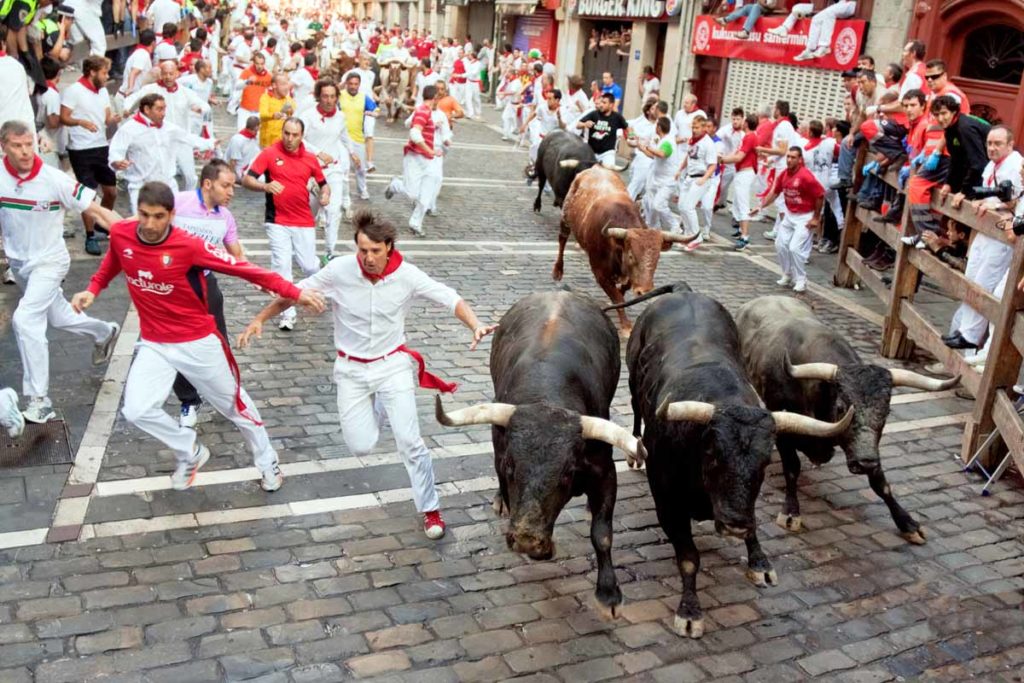
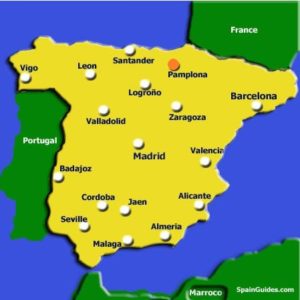
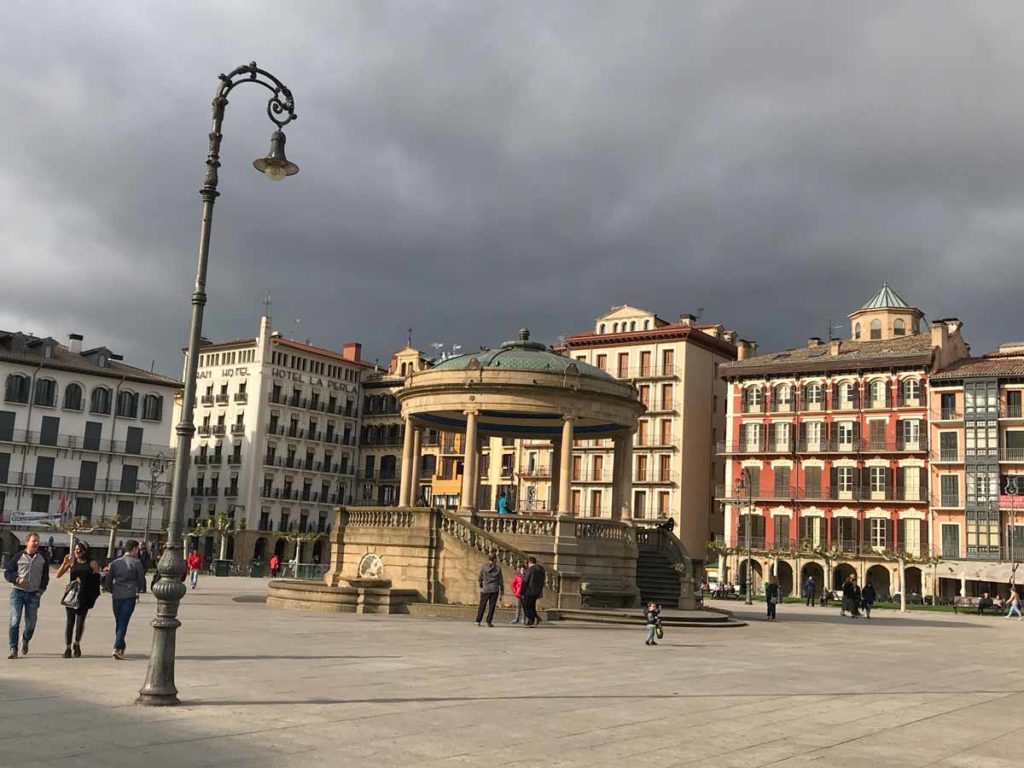
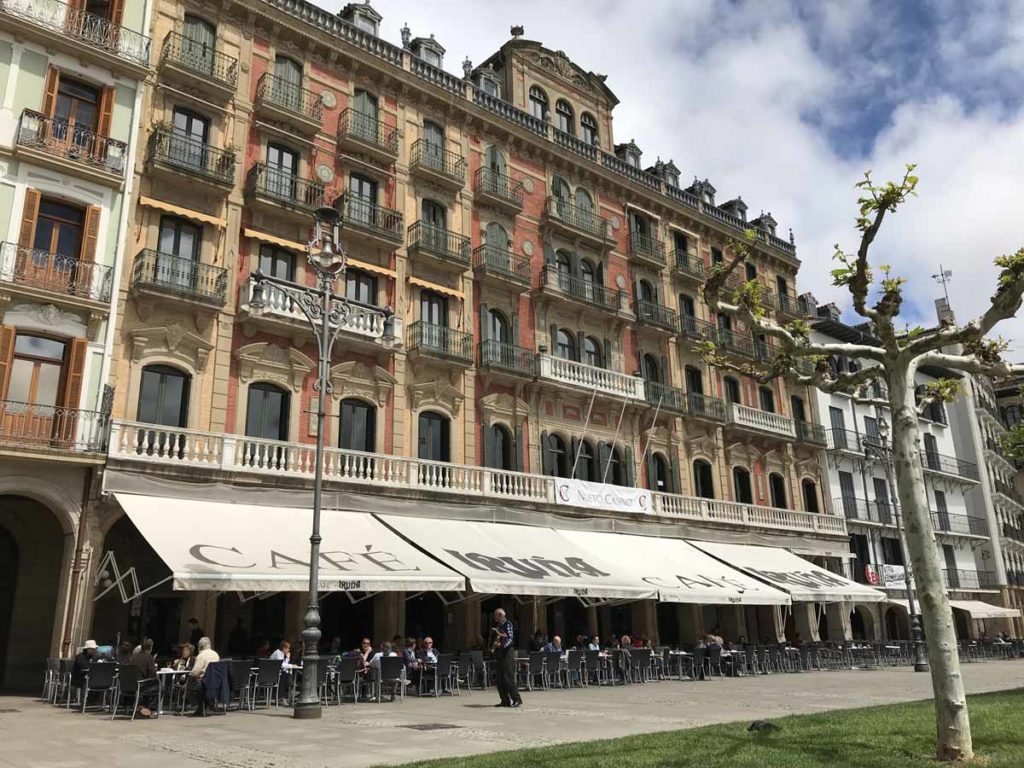
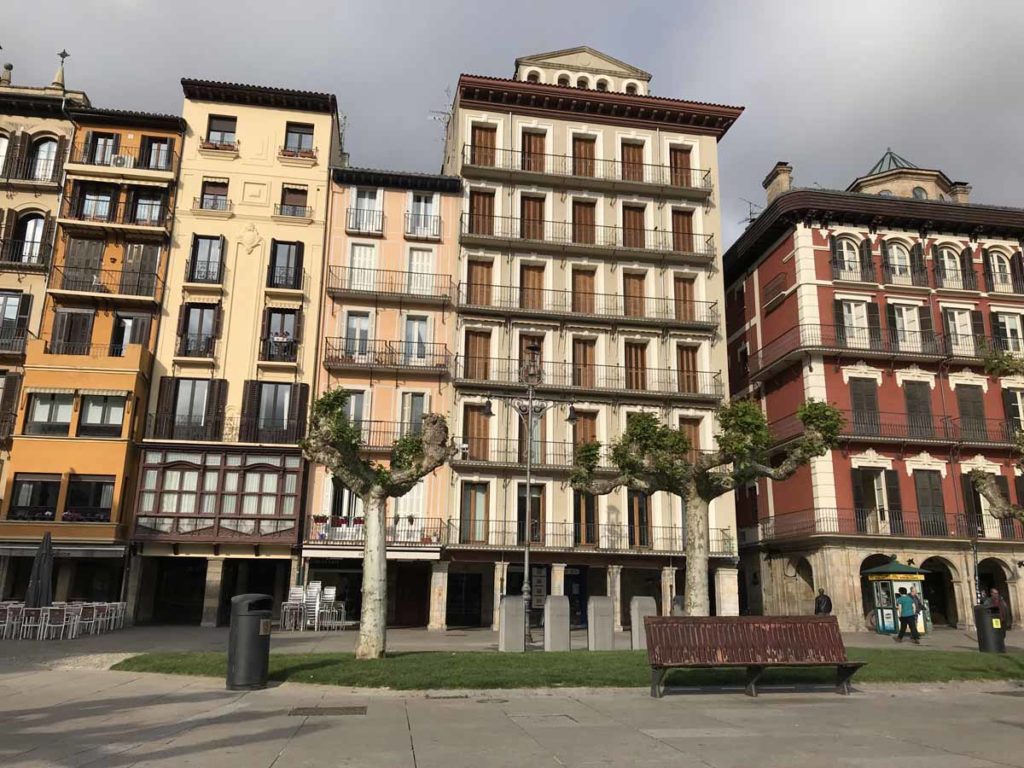
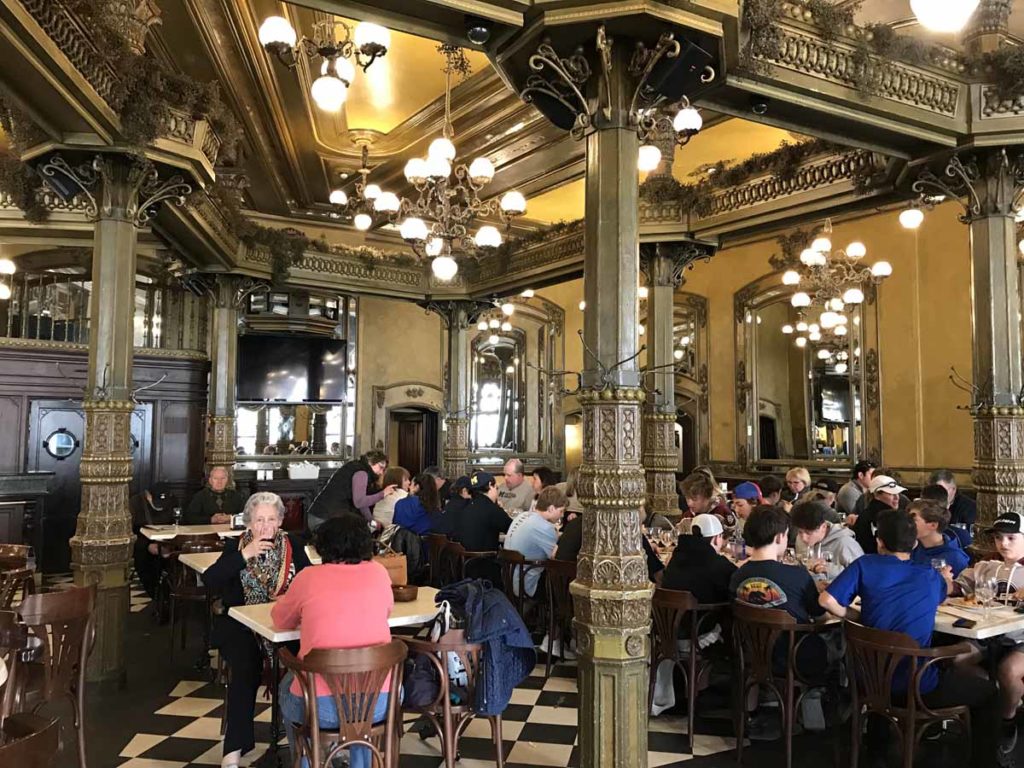
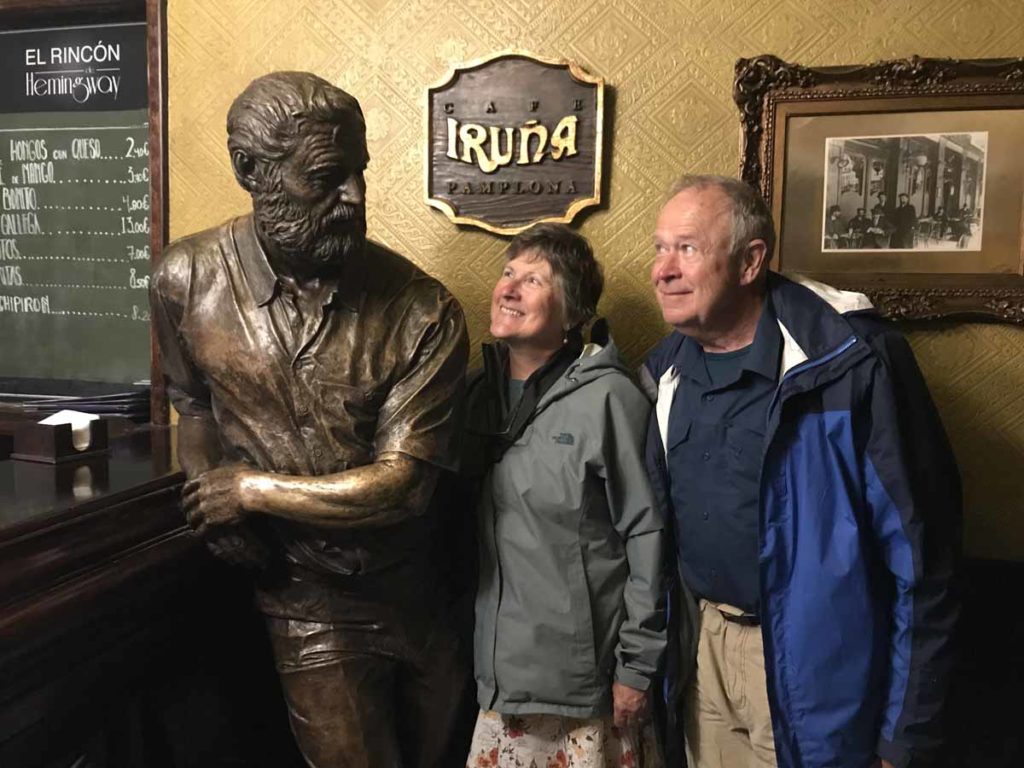
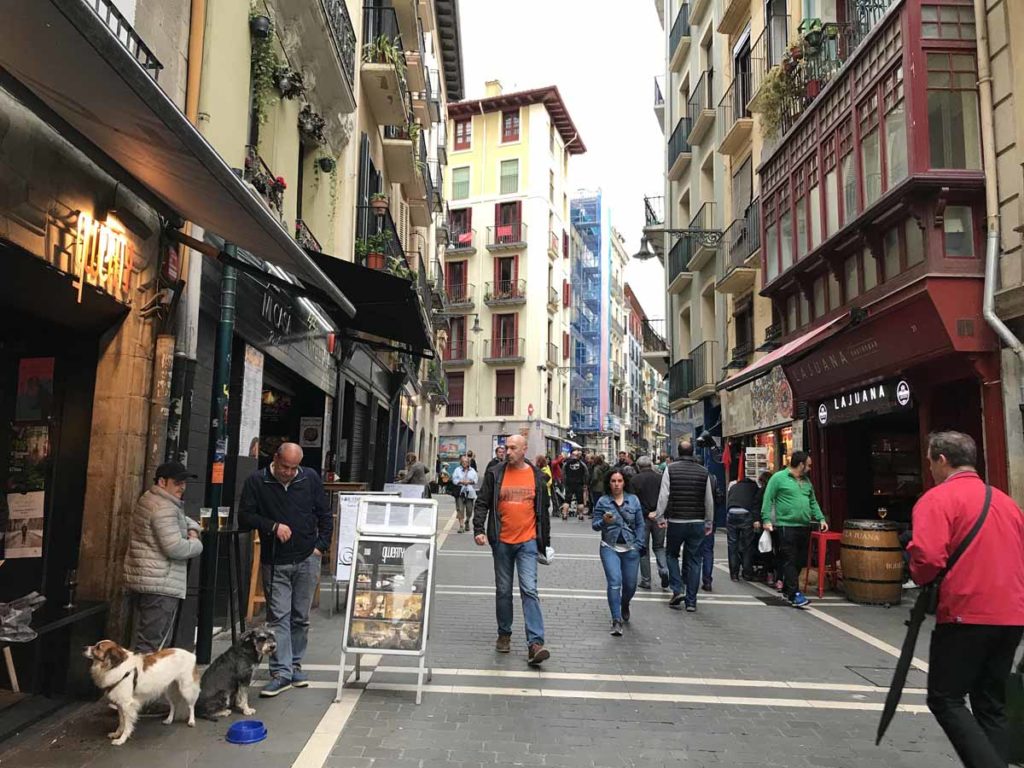
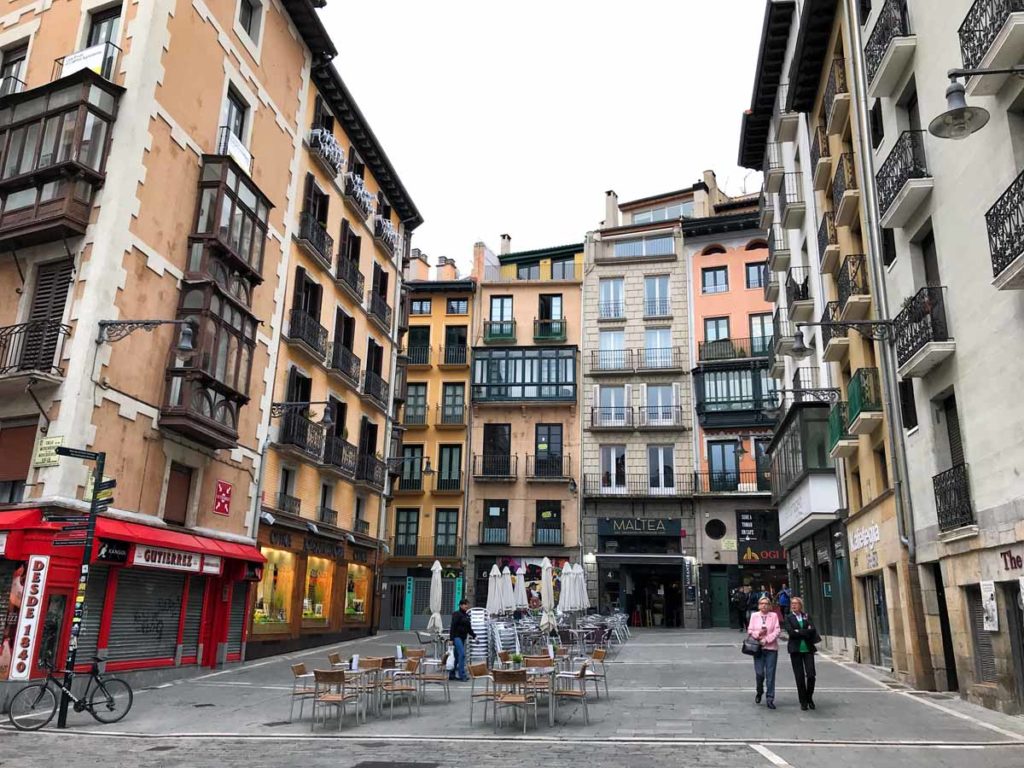
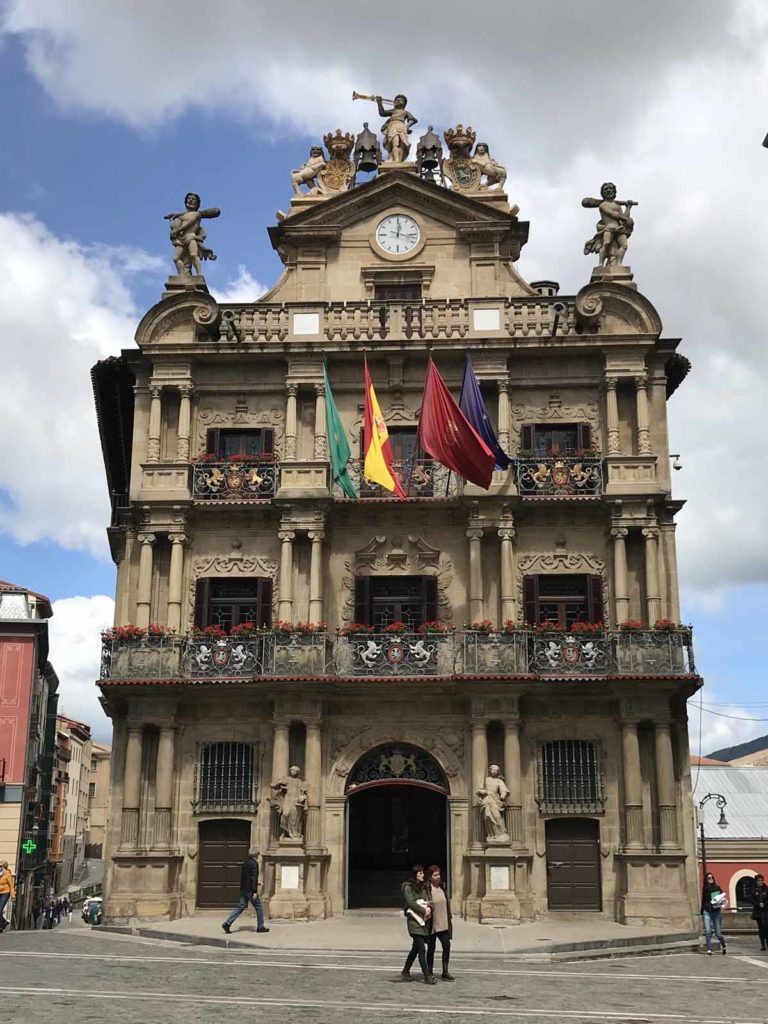
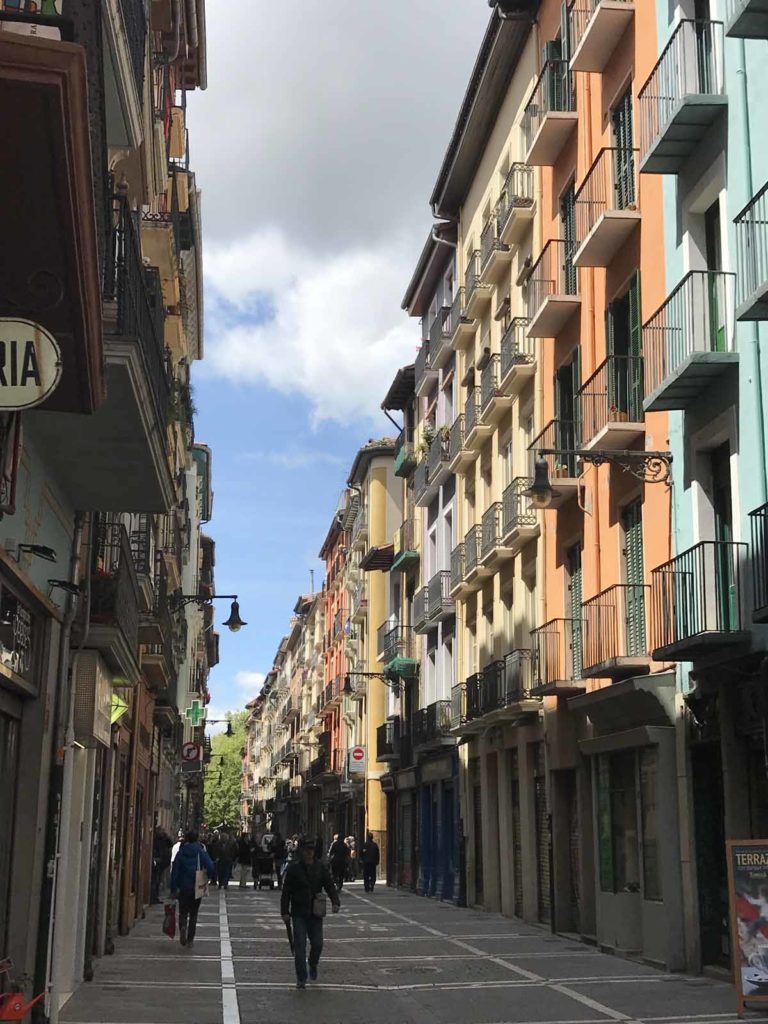
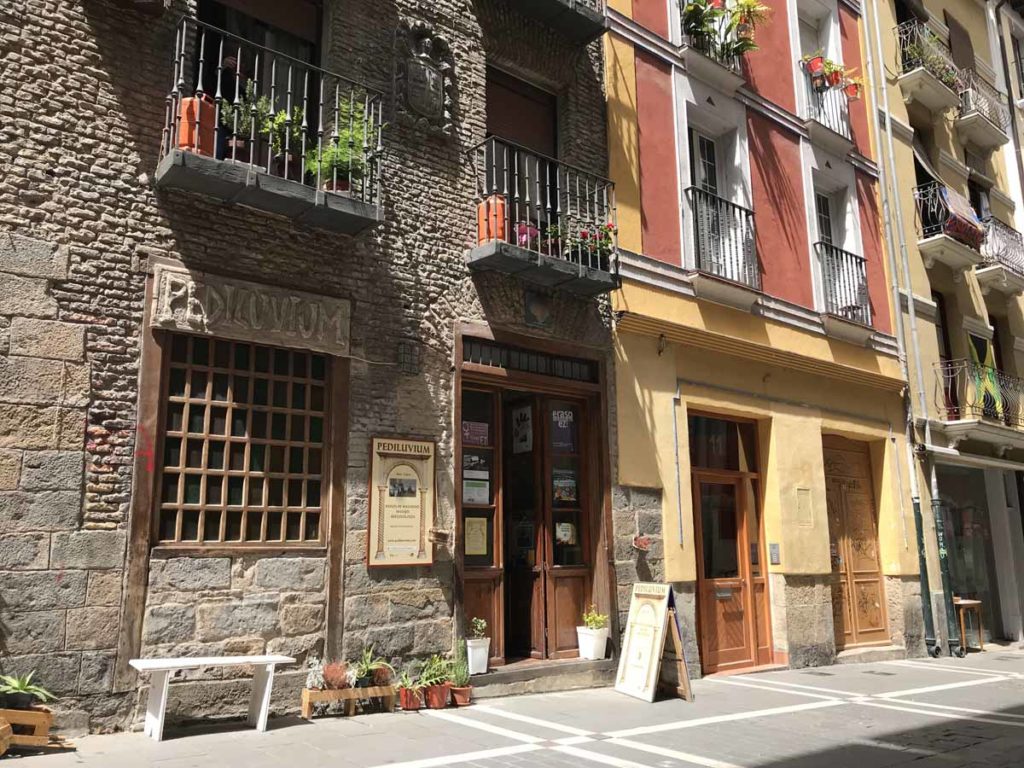
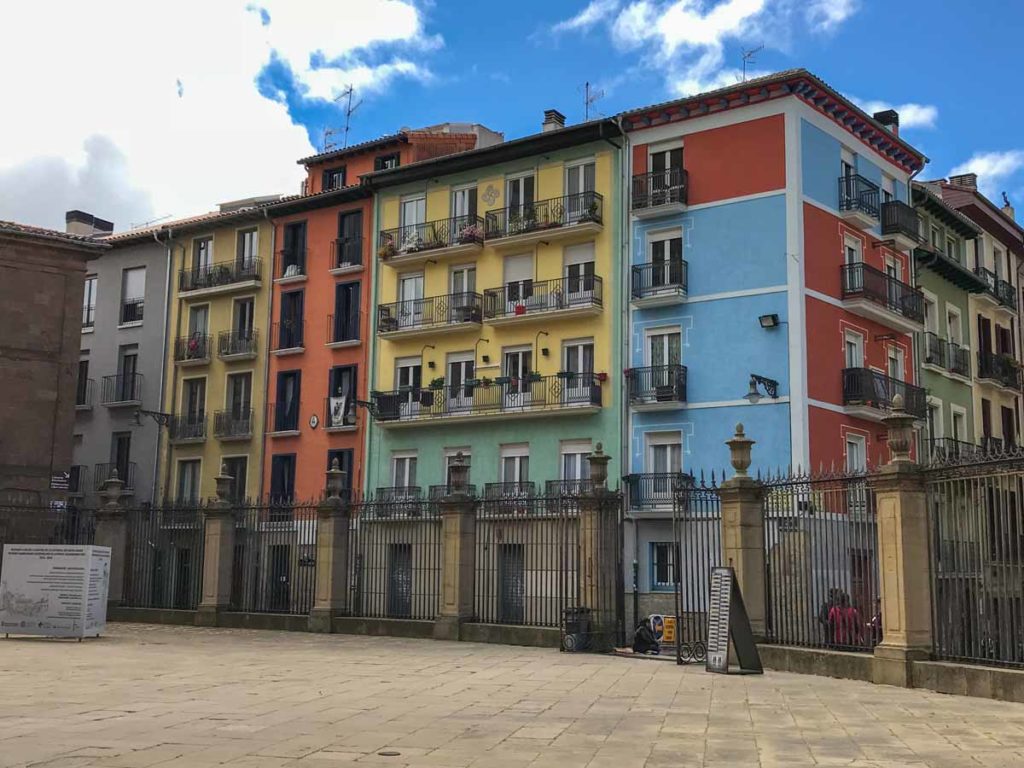
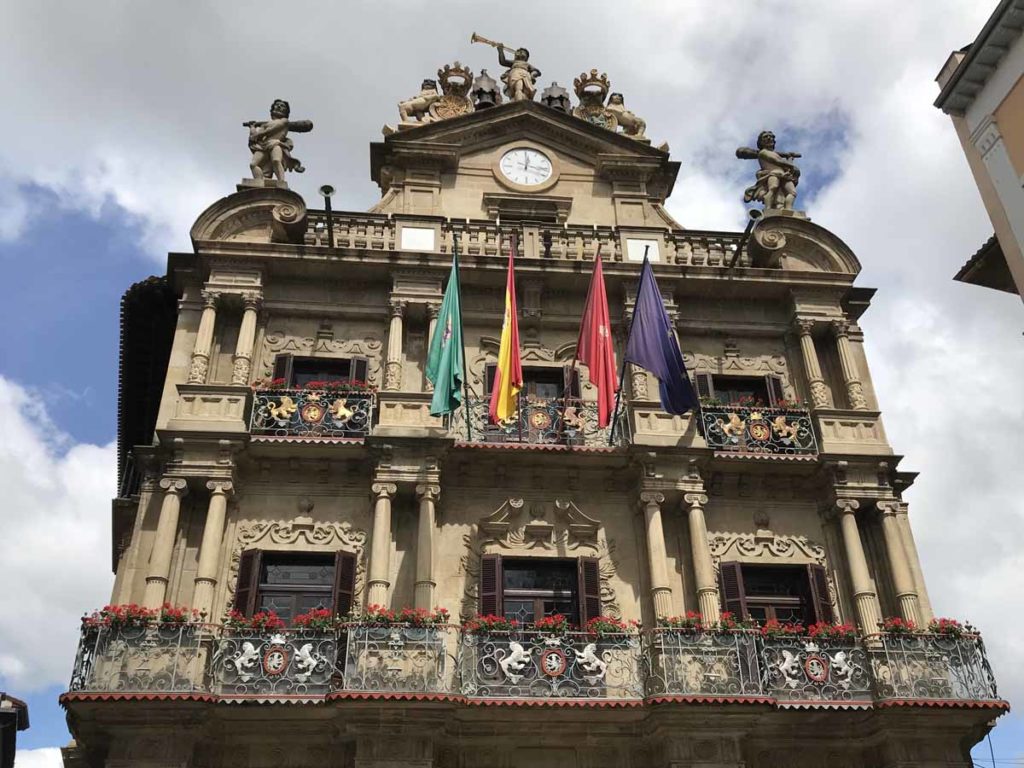
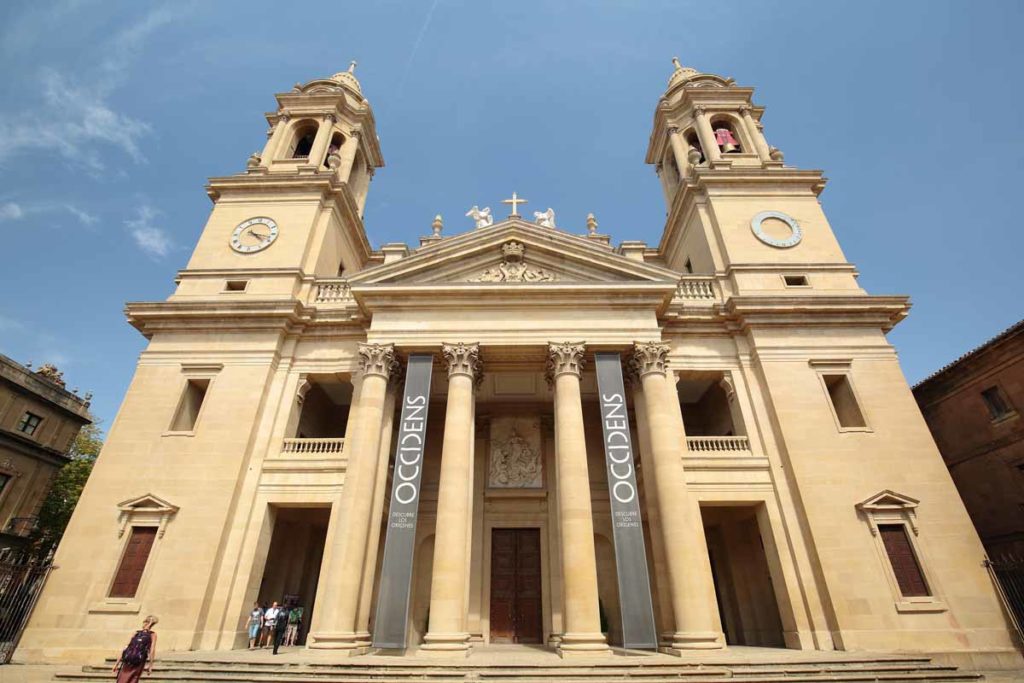
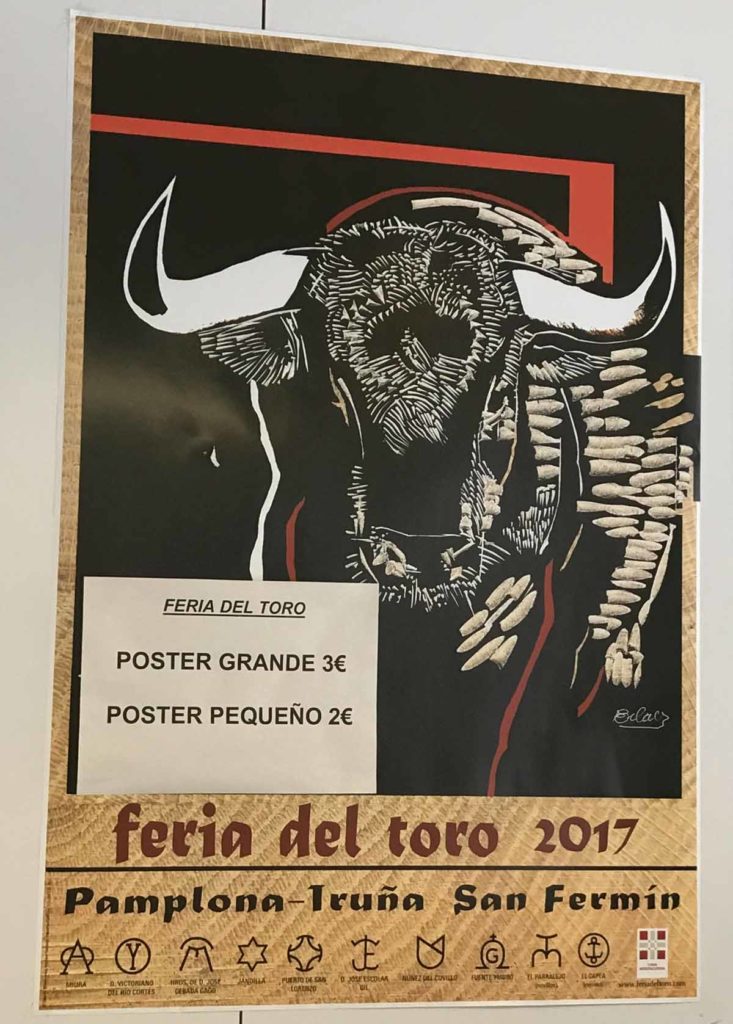
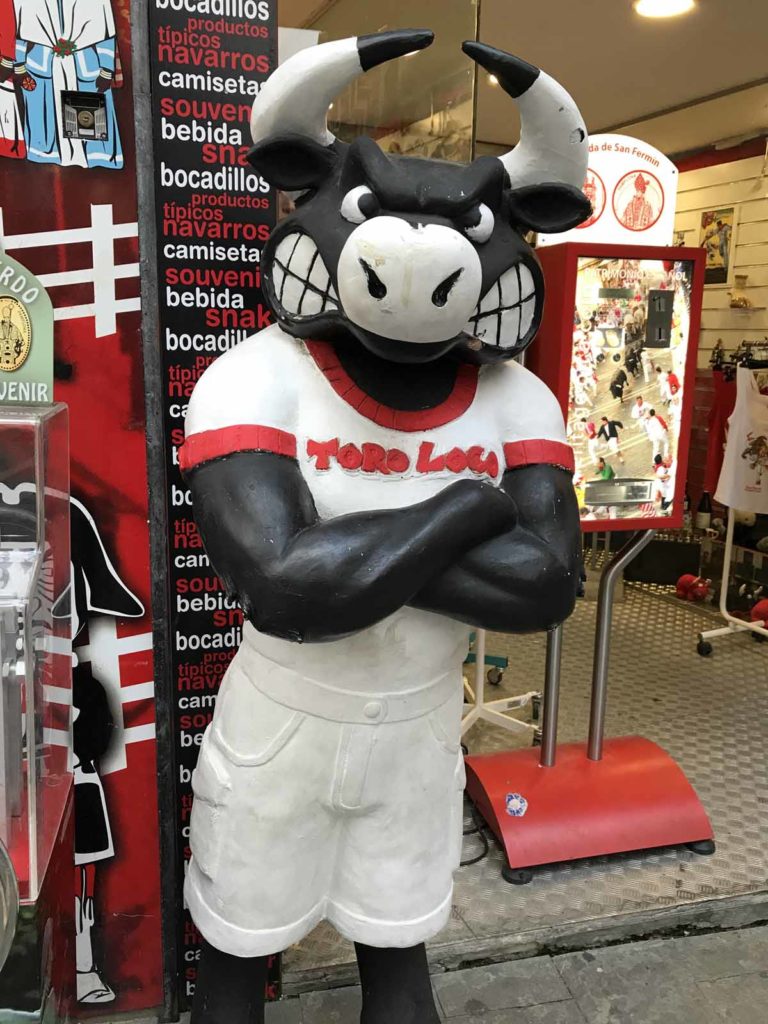
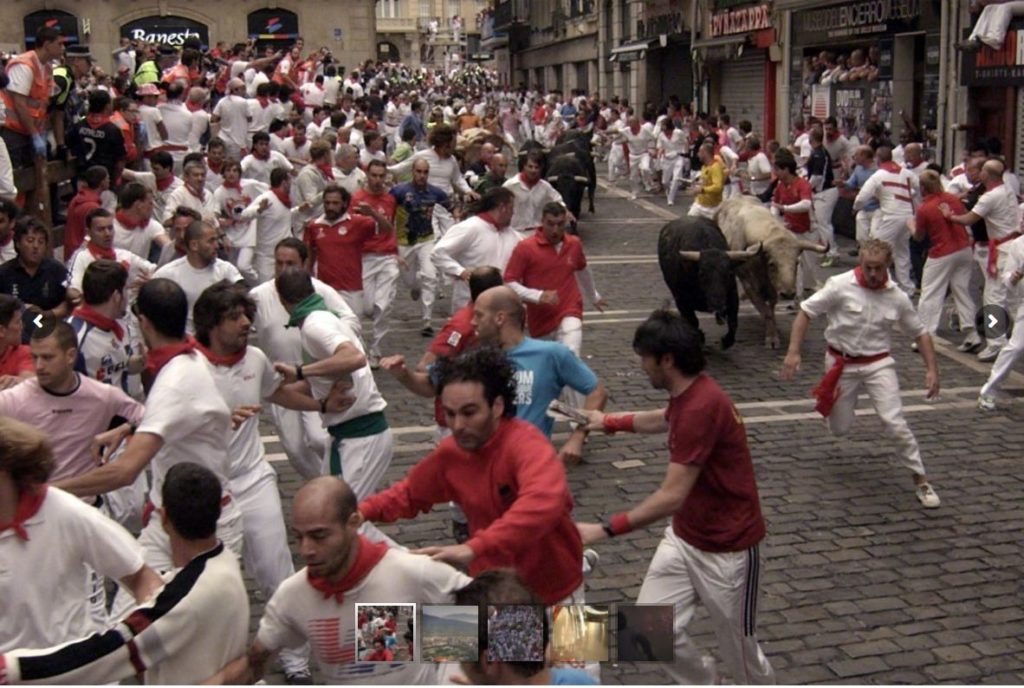
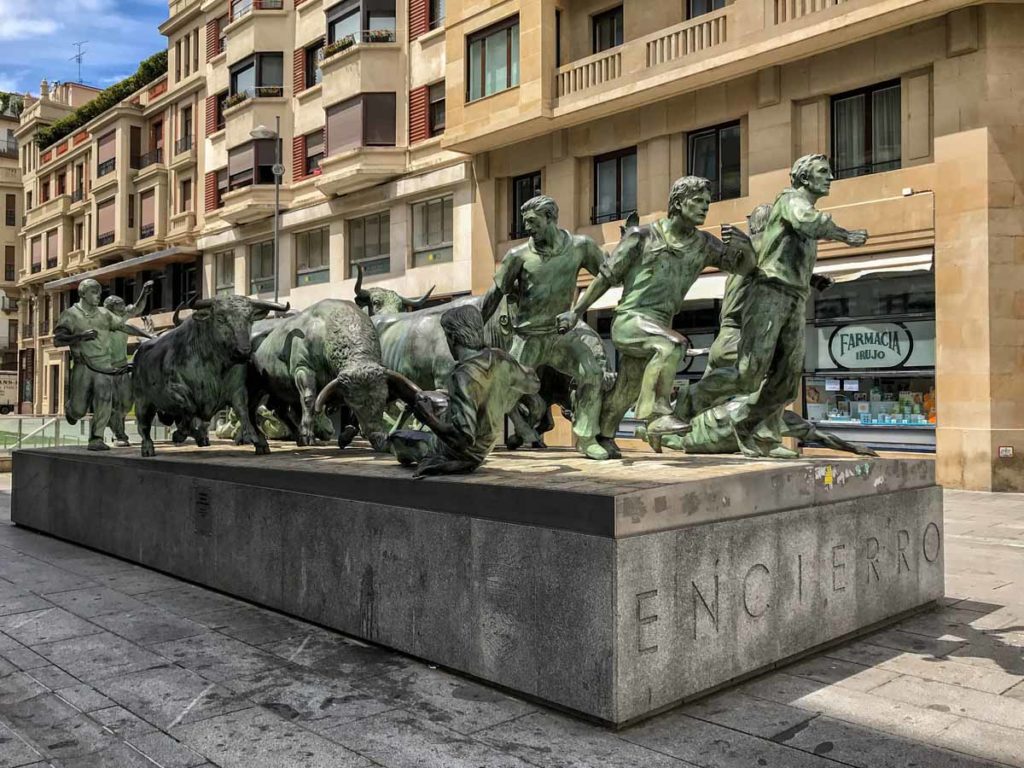
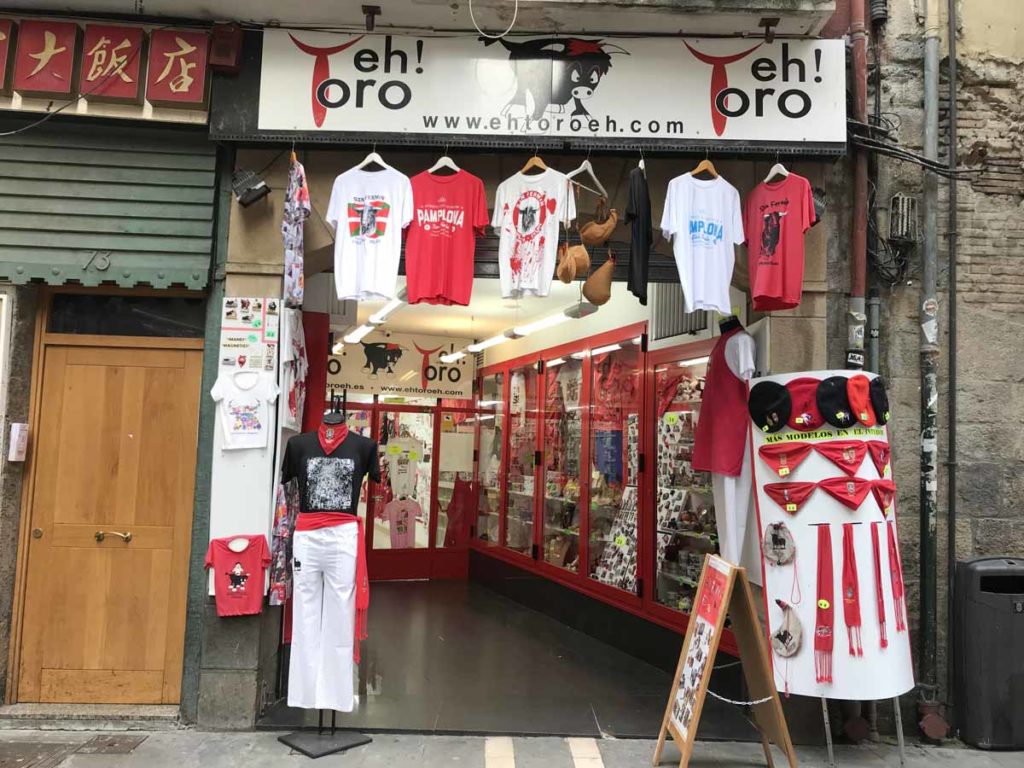
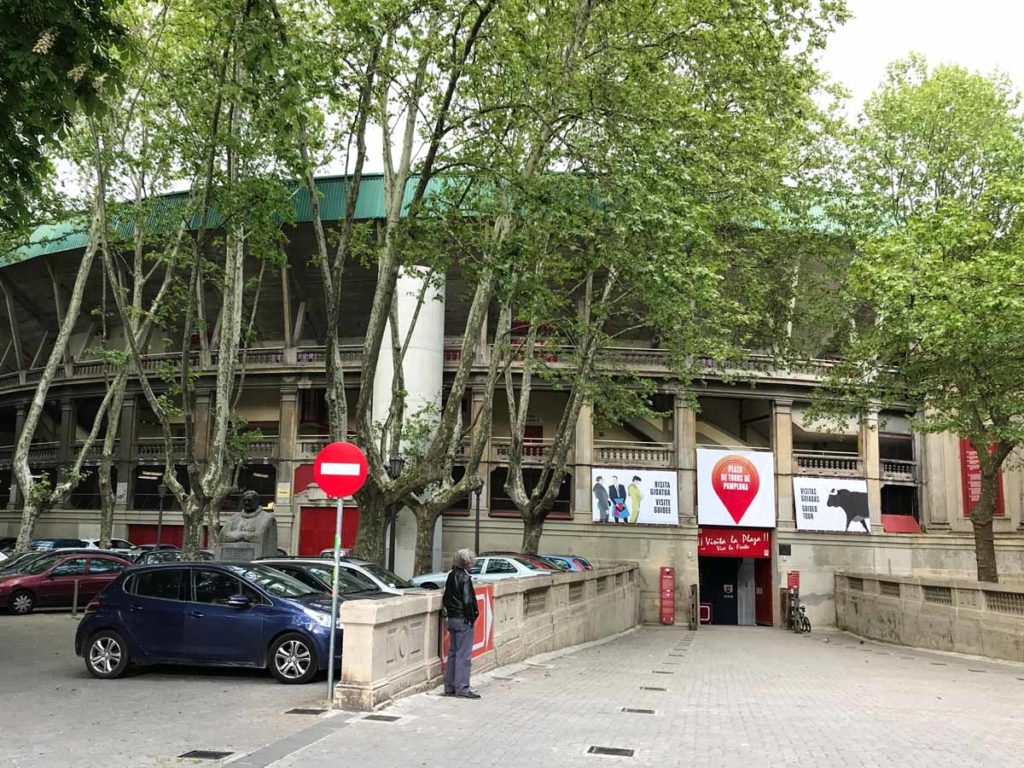
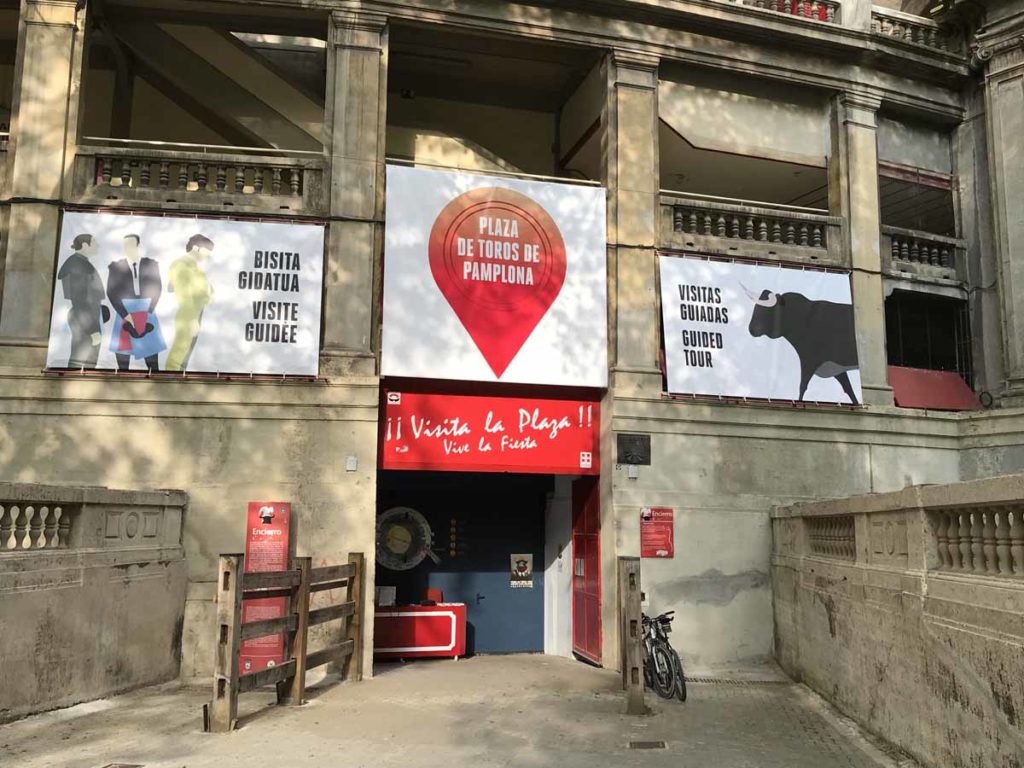
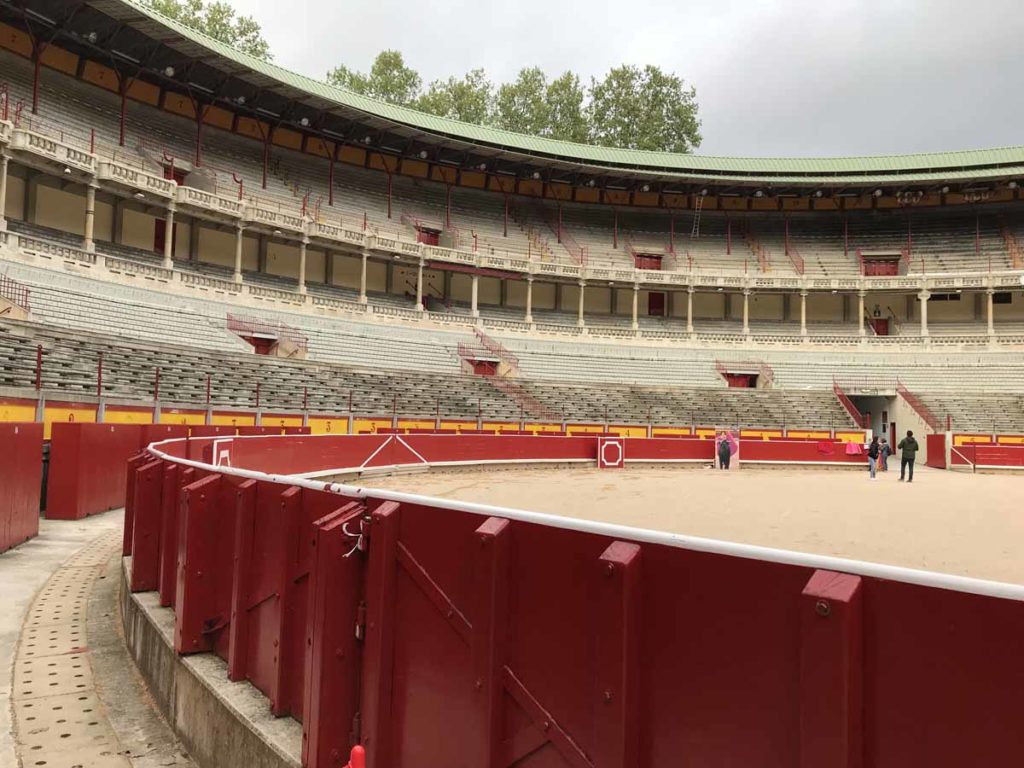
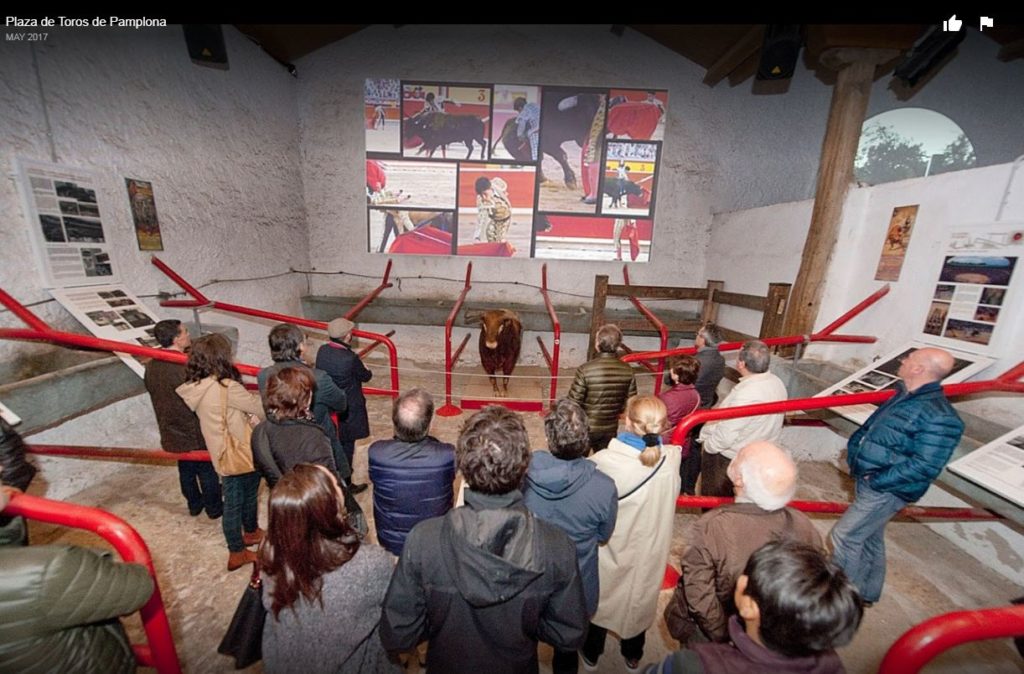
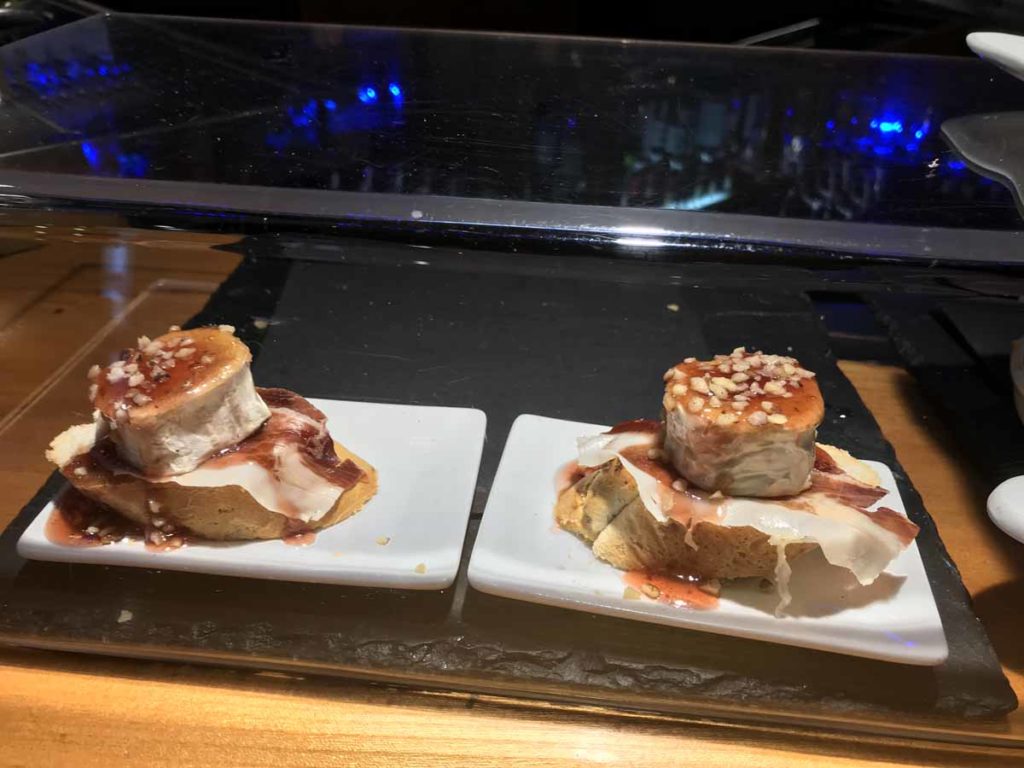
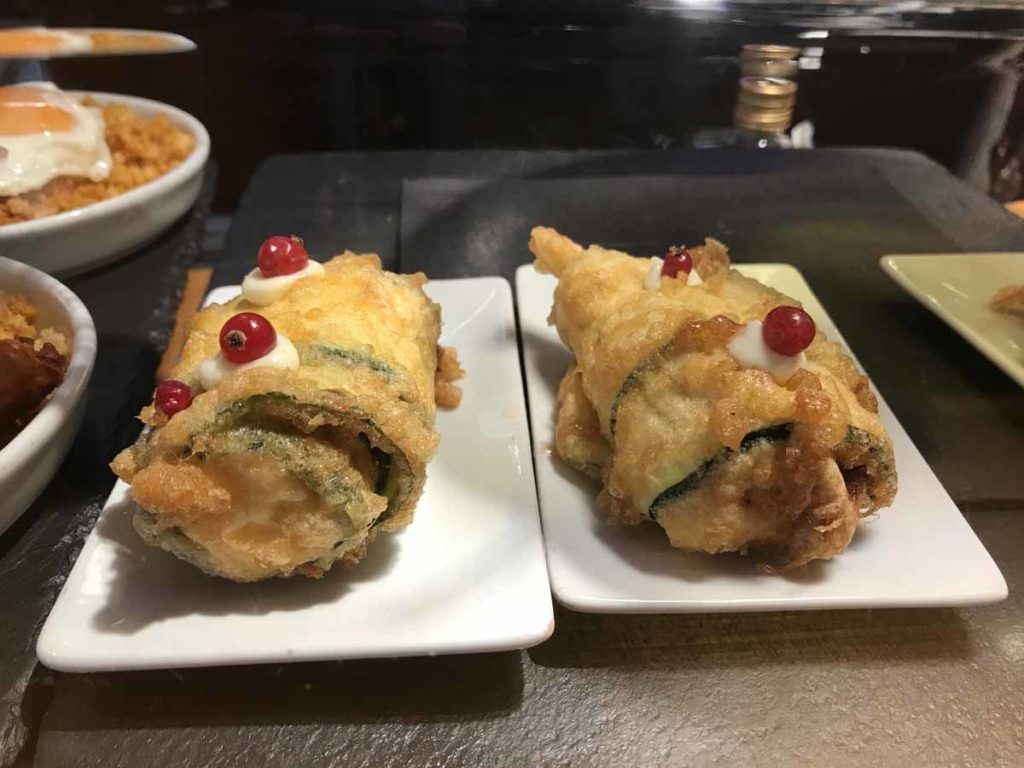
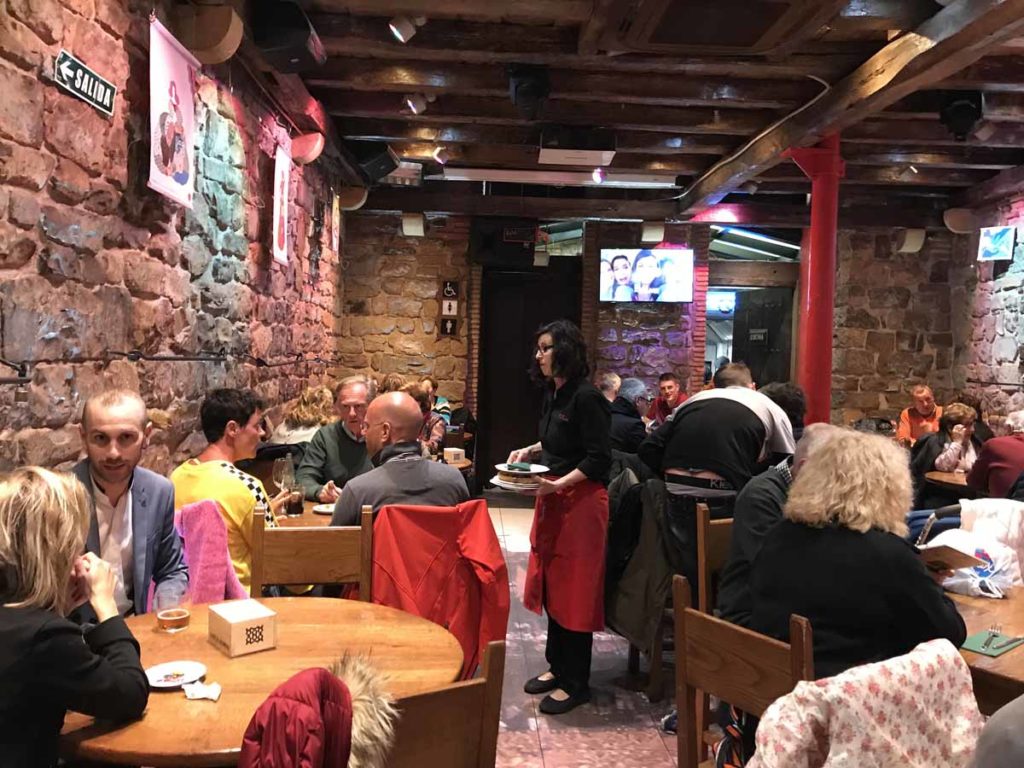
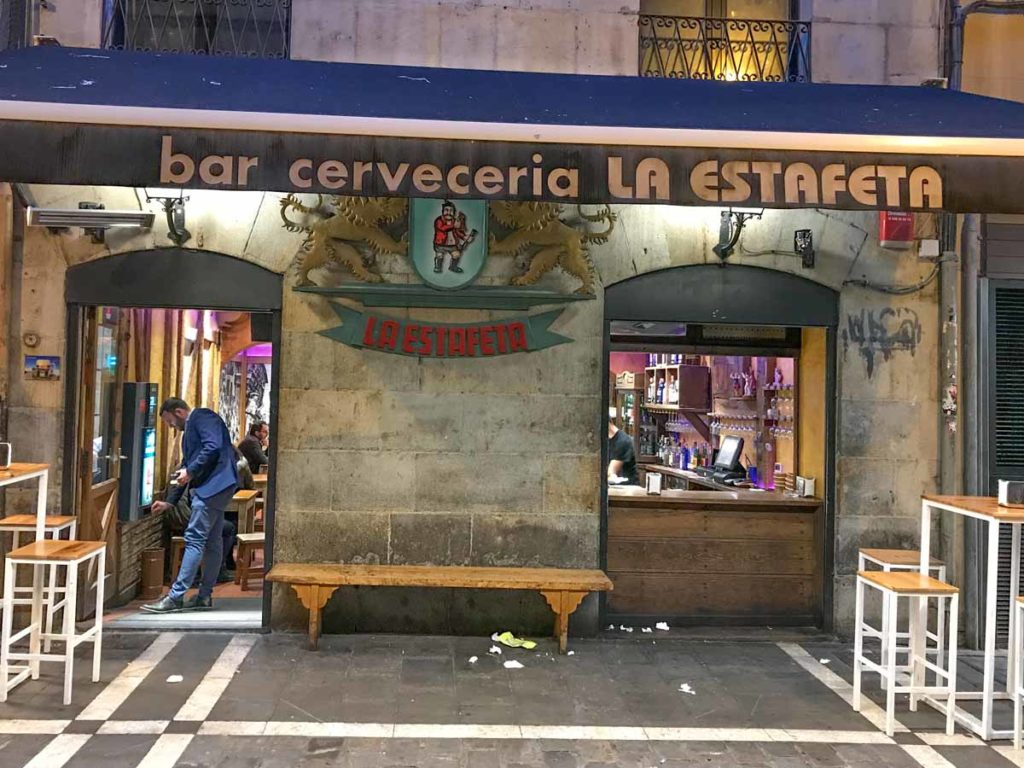
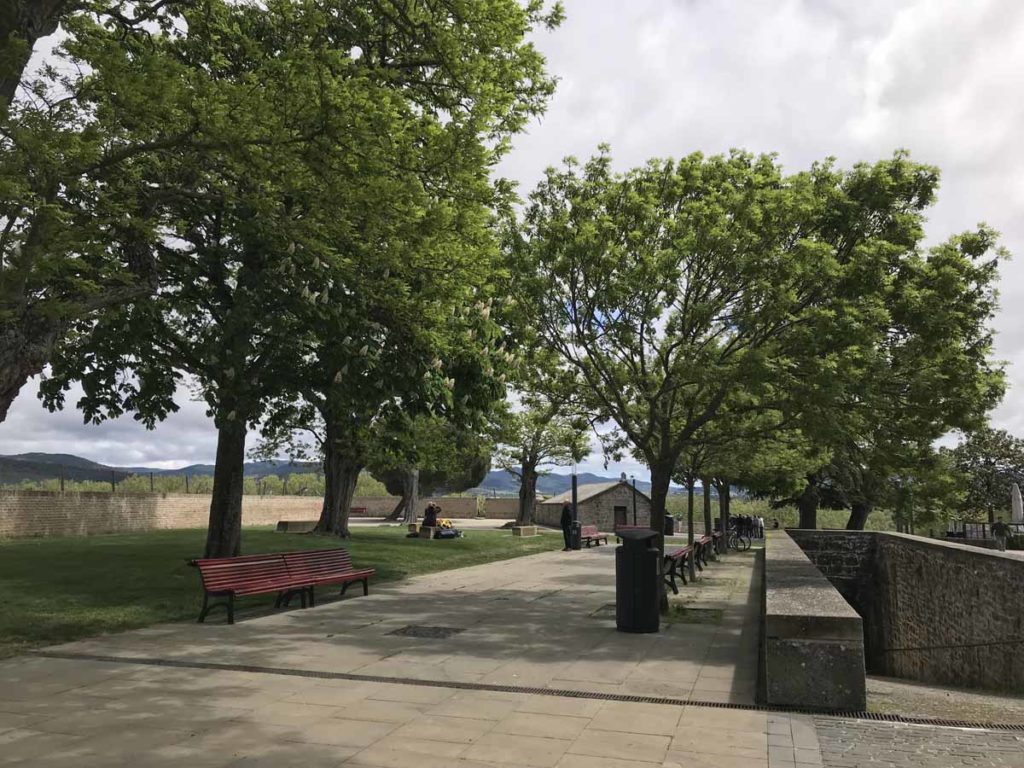
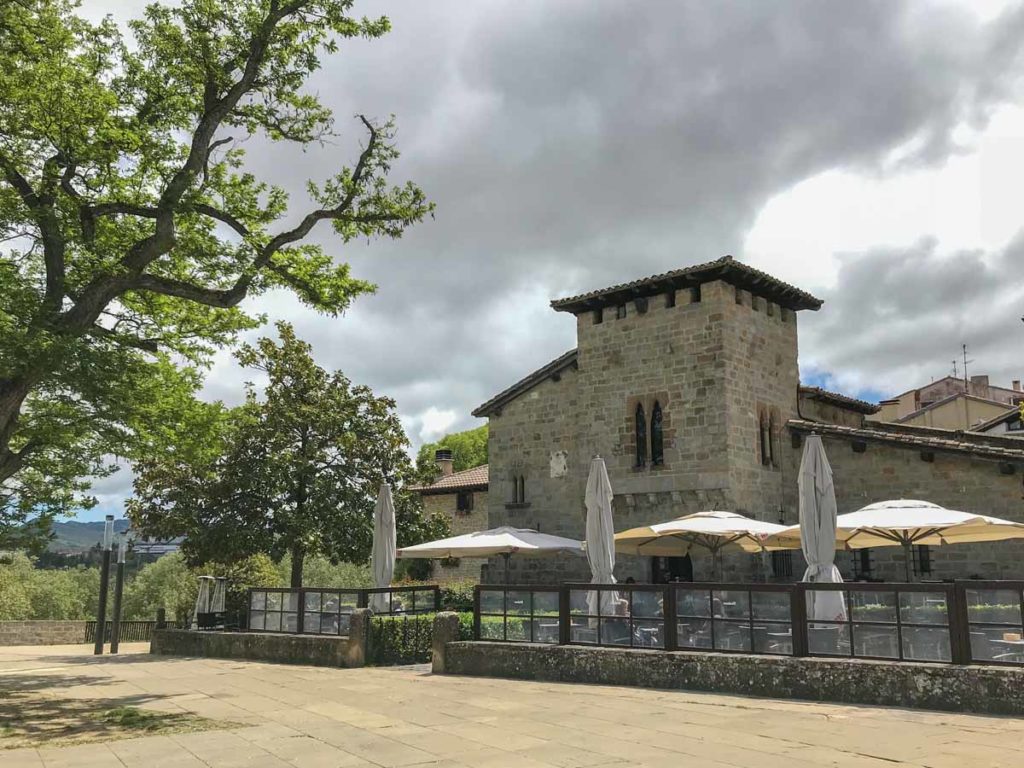
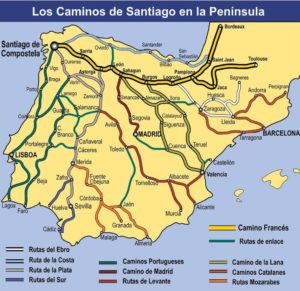
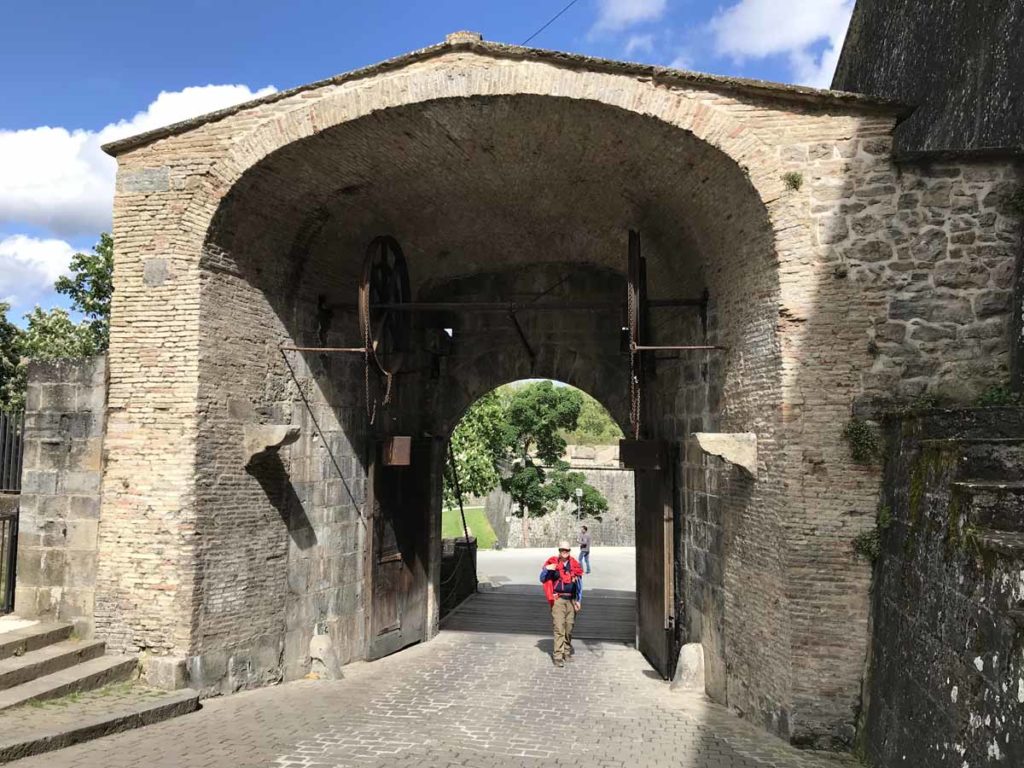
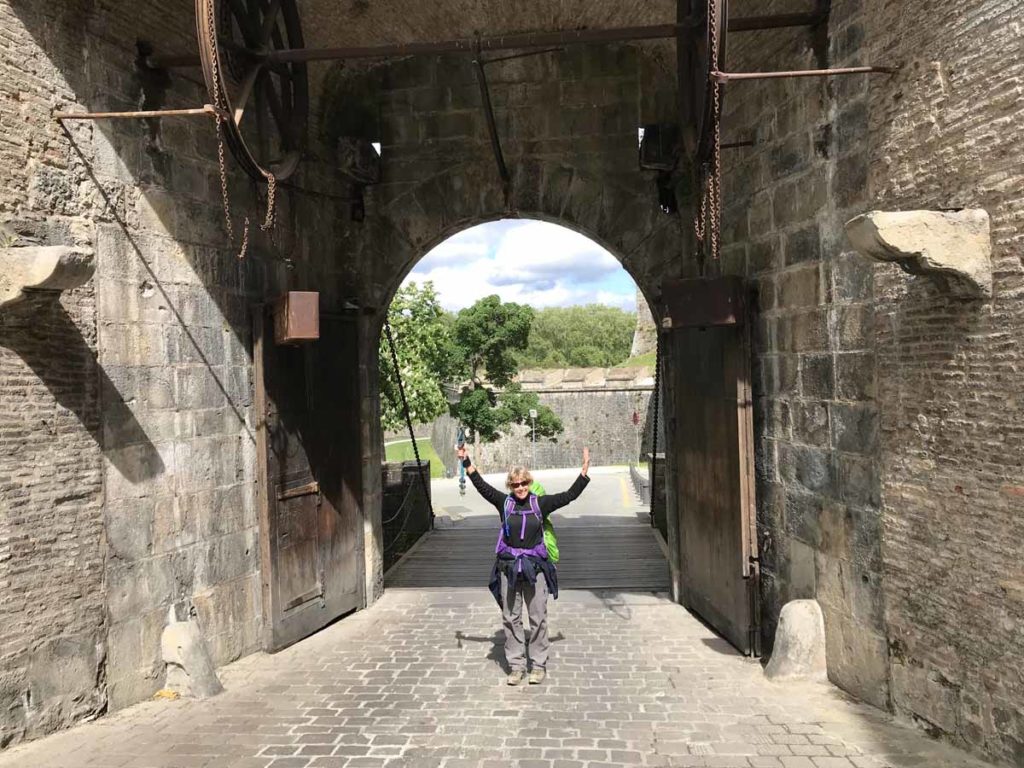
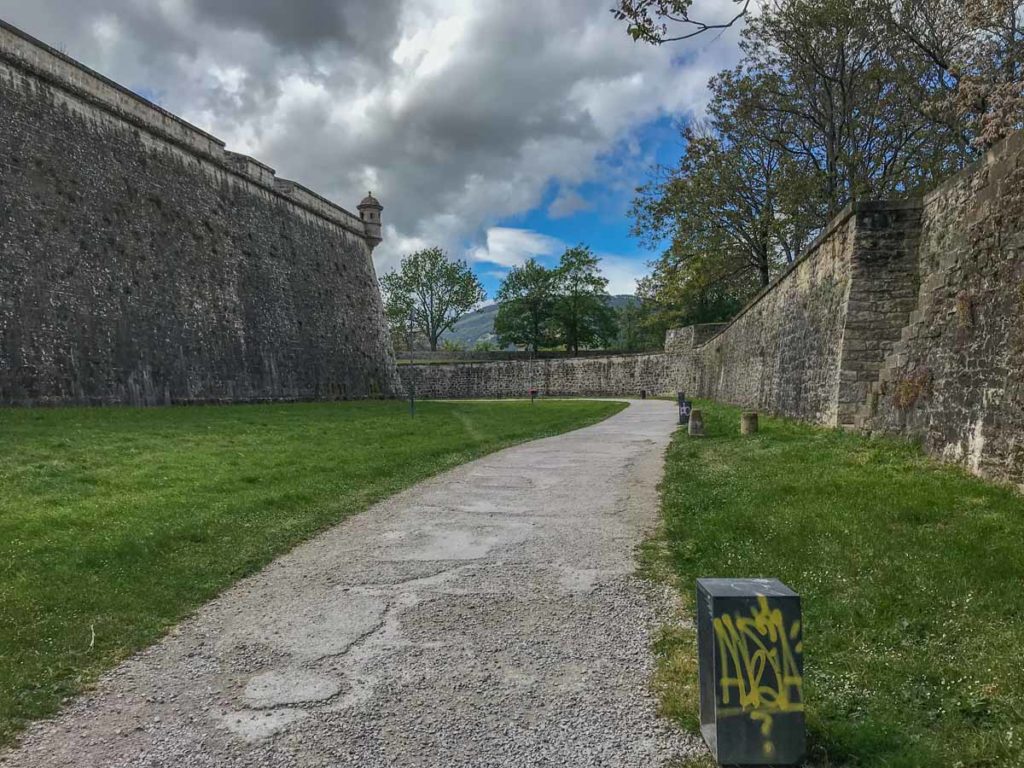
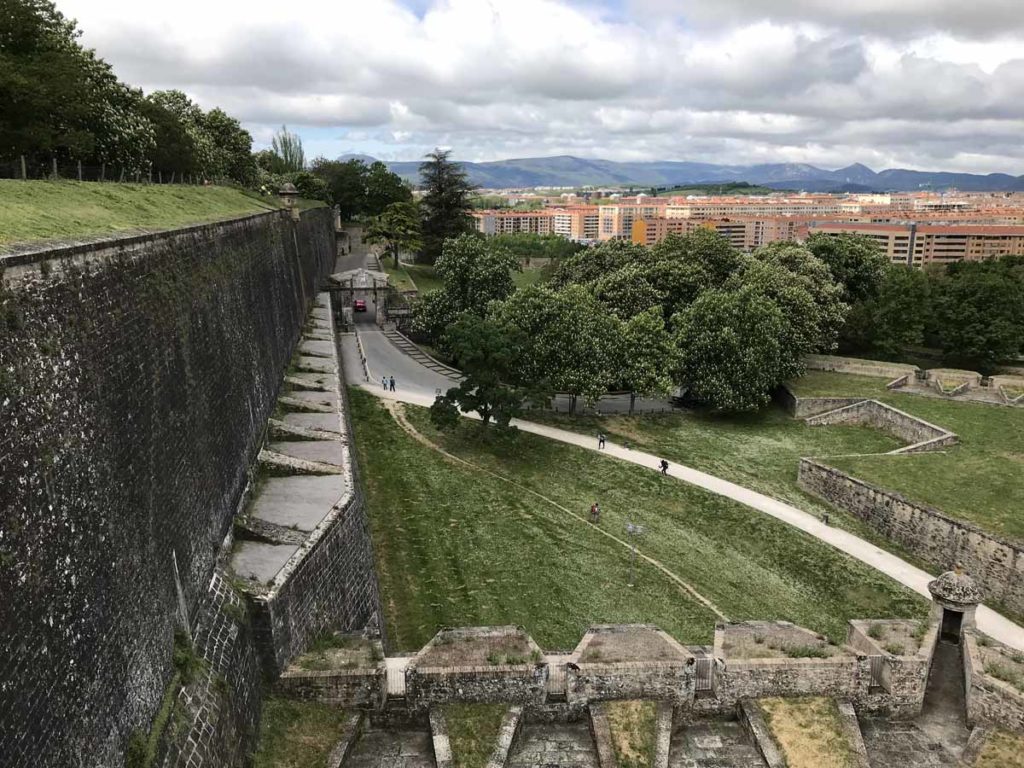
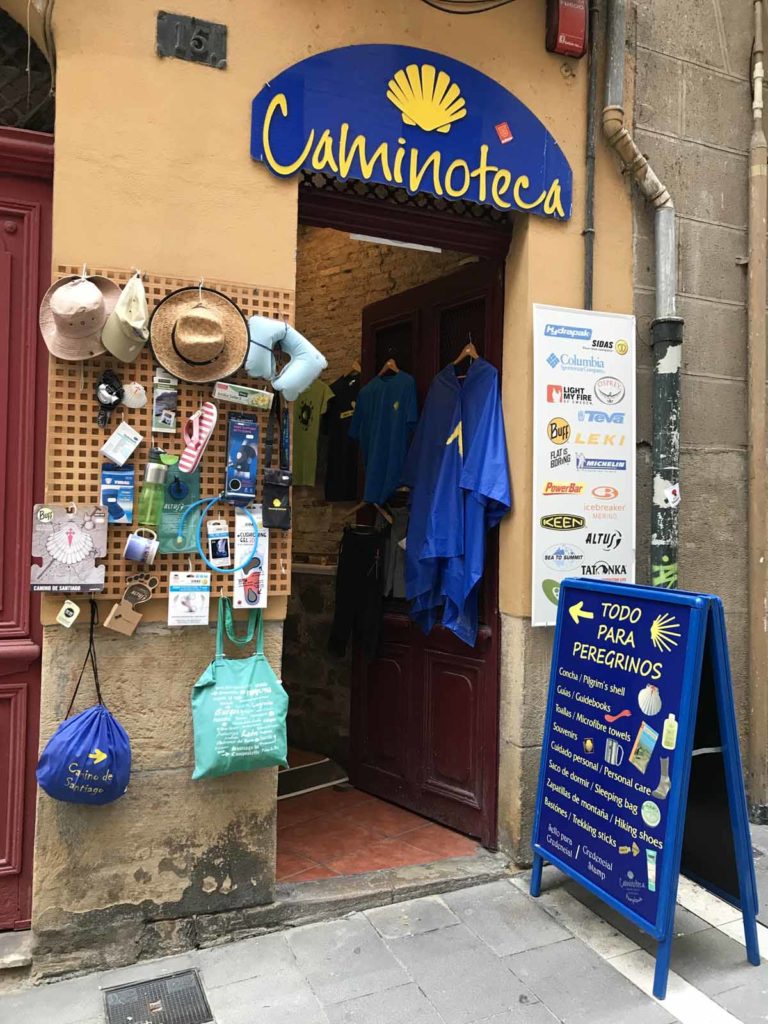
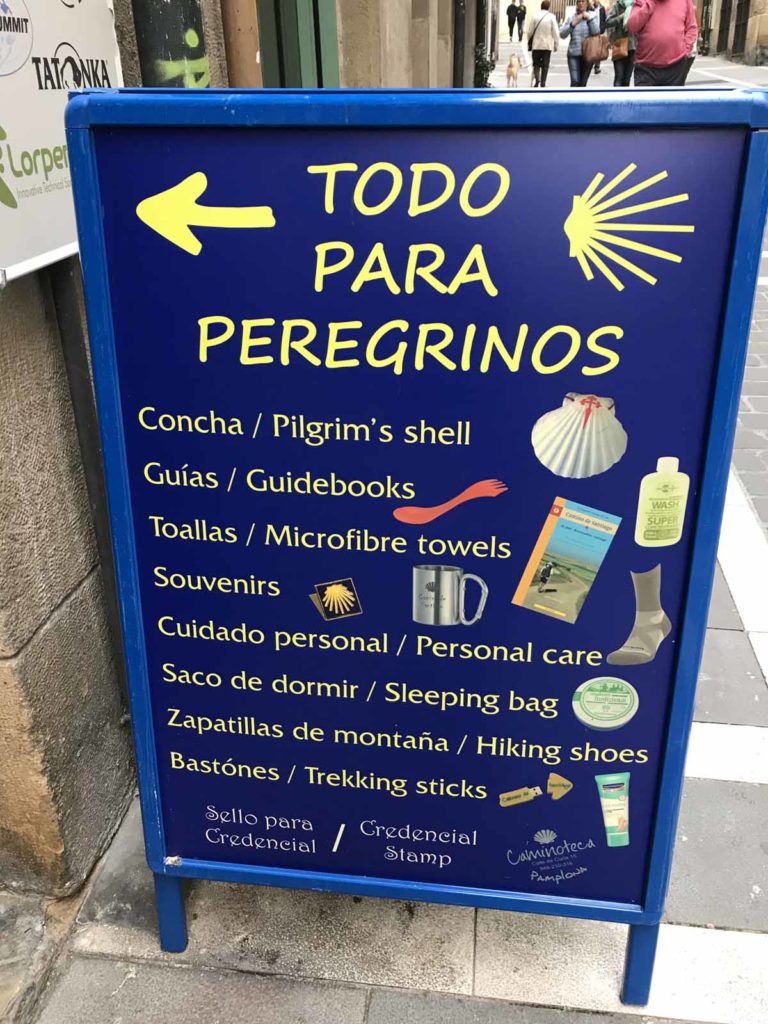
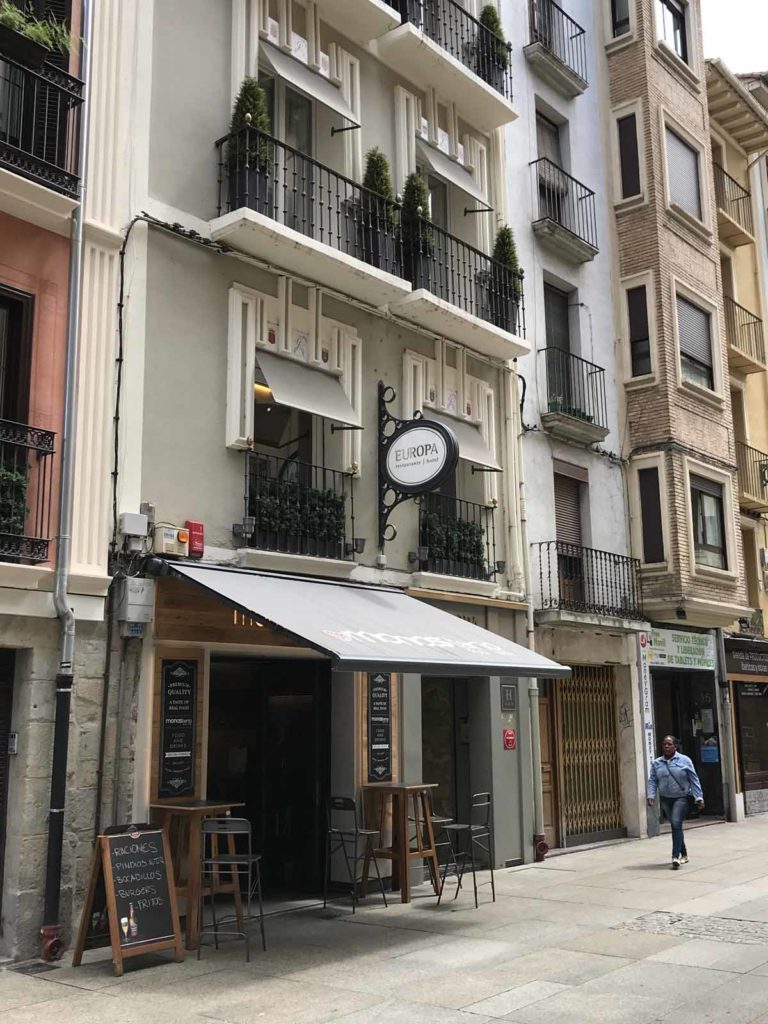
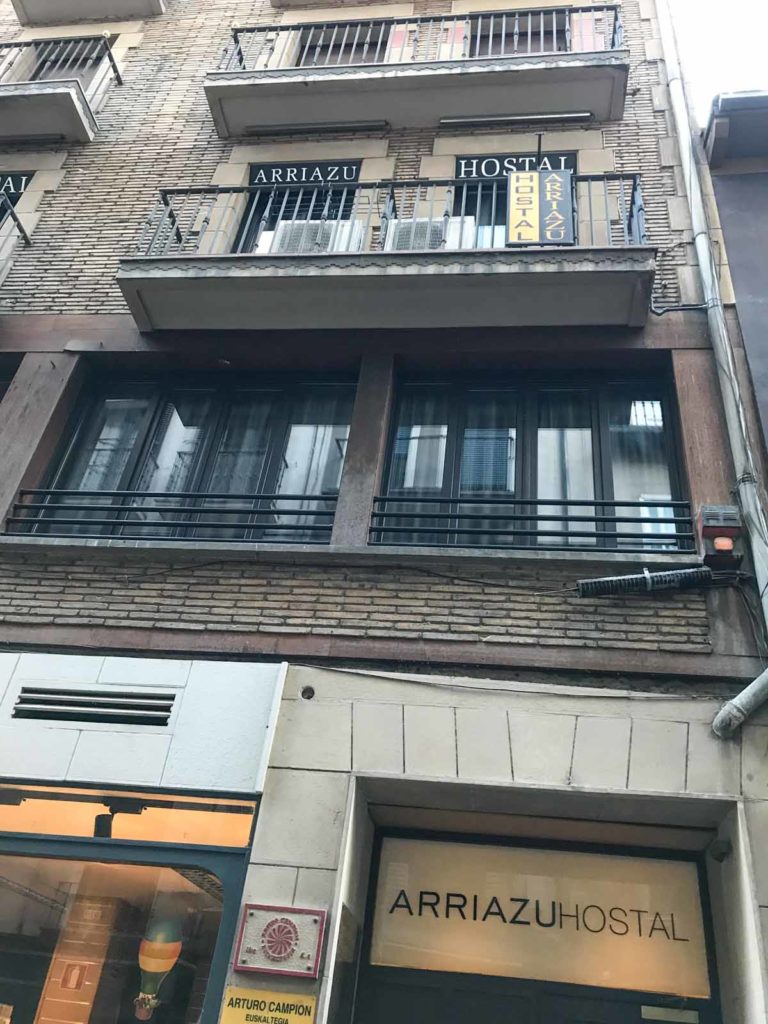
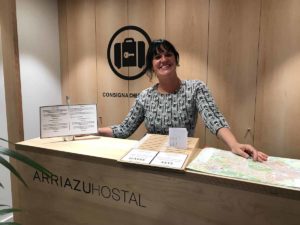
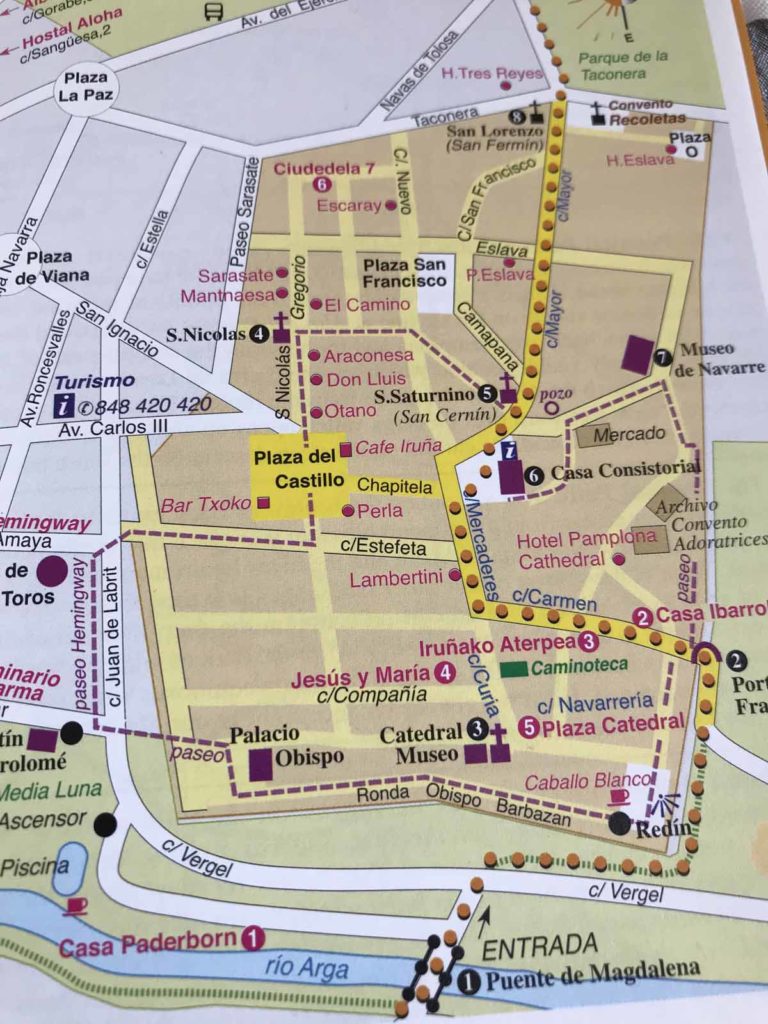
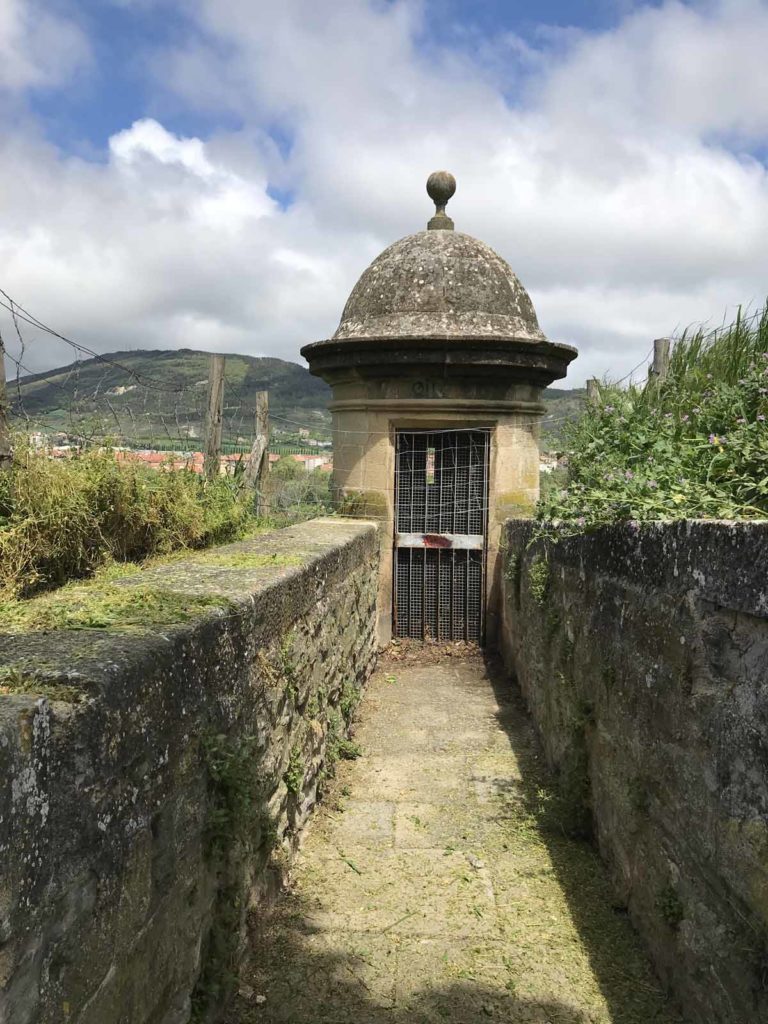
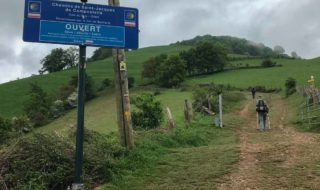
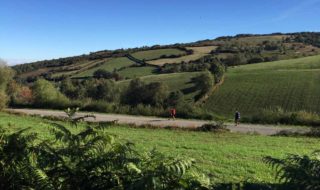
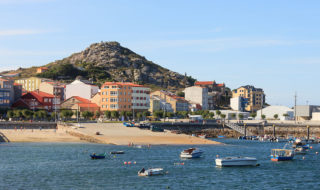
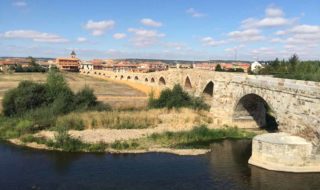
Thanks for the great memories of Pamplona. It is a great place to start an abbreviated Camino.
Thanks, Hal and you’re welcome. You’re quite right about Pamplona being a great start for the Camino Frances, for those who’d prefer to avoid the first particularly rigorous route section over the Pyrenees.